Maths Learning Centre Assessment Projects for CHCECE017
VerifiedAdded on 2023/06/17
|28
|6668
|149
AI Summary
This assessment tool is designed to plan a maths learning centre for a group of Toddler or Preschool children based on one of the concepts. It assists in assessing competence for CHCECE017 Foster the holistic development and wellbeing of the child in early childhood. The tool includes learning goals, rationale, resources, vocabulary, and questions to promote children's learning. It also includes small/large group experience plans and assessment of goal and concept development.
Contribute Materials
Your contribution can guide someone’s learning journey. Share your
documents today.
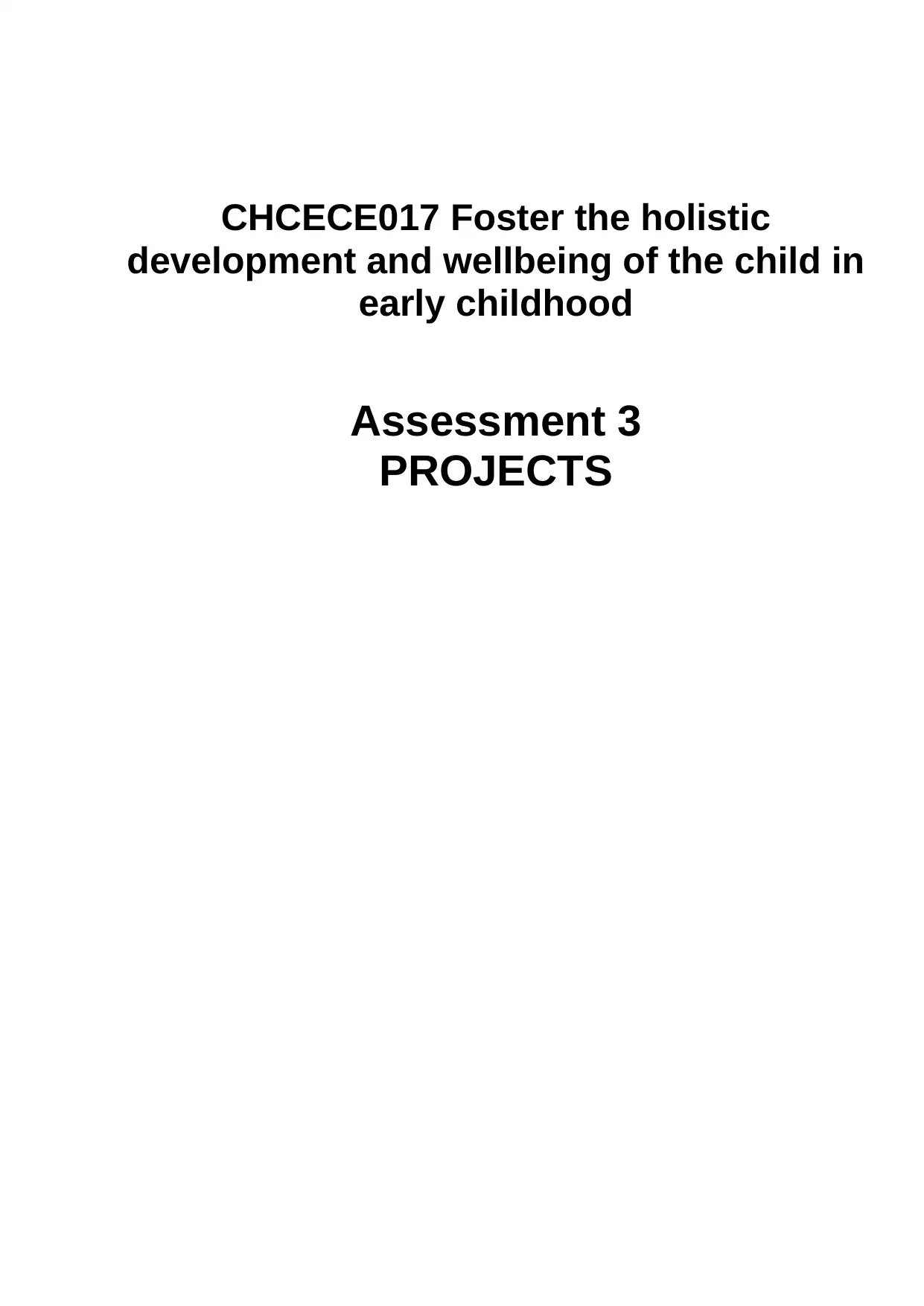
CHCECE017 Foster the holistic
development and wellbeing of the child in
early childhood
Assessment 3
PROJECTS
development and wellbeing of the child in
early childhood
Assessment 3
PROJECTS
Secure Best Marks with AI Grader
Need help grading? Try our AI Grader for instant feedback on your assignments.
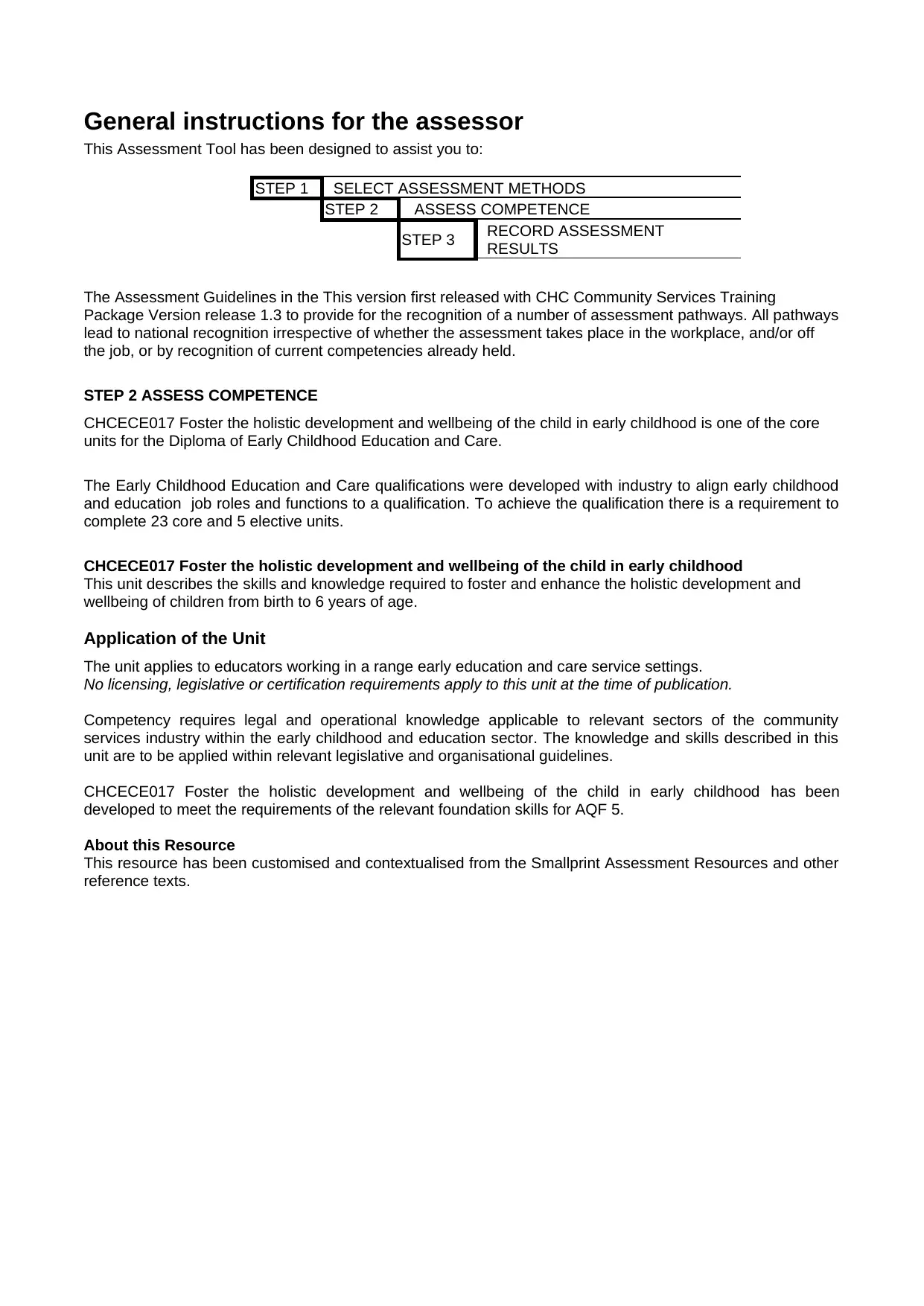
General instructions for the assessor
This Assessment Tool has been designed to assist you to:
STEP 1 SELECT ASSESSMENT METHODS
STEP 2 ASSESS COMPETENCE
STEP 3 RECORD ASSESSMENT
RESULTS
The Assessment Guidelines in the This version first released with CHC Community Services Training
Package Version release 1.3 to provide for the recognition of a number of assessment pathways. All pathways
lead to national recognition irrespective of whether the assessment takes place in the workplace, and/or off
the job, or by recognition of current competencies already held.
STEP 2 ASSESS COMPETENCE
CHCECE017 Foster the holistic development and wellbeing of the child in early childhood is one of the core
units for the Diploma of Early Childhood Education and Care.
The Early Childhood Education and Care qualifications were developed with industry to align early childhood
and education job roles and functions to a qualification. To achieve the qualification there is a requirement to
complete 23 core and 5 elective units.
CHCECE017 Foster the holistic development and wellbeing of the child in early childhood
This unit describes the skills and knowledge required to foster and enhance the holistic development and
wellbeing of children from birth to 6 years of age.
Application of the Unit
The unit applies to educators working in a range early education and care service settings.
No licensing, legislative or certification requirements apply to this unit at the time of publication.
Competency requires legal and operational knowledge applicable to relevant sectors of the community
services industry within the early childhood and education sector. The knowledge and skills described in this
unit are to be applied within relevant legislative and organisational guidelines.
CHCECE017 Foster the holistic development and wellbeing of the child in early childhood has been
developed to meet the requirements of the relevant foundation skills for AQF 5.
About this Resource
This resource has been customised and contextualised from the Smallprint Assessment Resources and other
reference texts.
This Assessment Tool has been designed to assist you to:
STEP 1 SELECT ASSESSMENT METHODS
STEP 2 ASSESS COMPETENCE
STEP 3 RECORD ASSESSMENT
RESULTS
The Assessment Guidelines in the This version first released with CHC Community Services Training
Package Version release 1.3 to provide for the recognition of a number of assessment pathways. All pathways
lead to national recognition irrespective of whether the assessment takes place in the workplace, and/or off
the job, or by recognition of current competencies already held.
STEP 2 ASSESS COMPETENCE
CHCECE017 Foster the holistic development and wellbeing of the child in early childhood is one of the core
units for the Diploma of Early Childhood Education and Care.
The Early Childhood Education and Care qualifications were developed with industry to align early childhood
and education job roles and functions to a qualification. To achieve the qualification there is a requirement to
complete 23 core and 5 elective units.
CHCECE017 Foster the holistic development and wellbeing of the child in early childhood
This unit describes the skills and knowledge required to foster and enhance the holistic development and
wellbeing of children from birth to 6 years of age.
Application of the Unit
The unit applies to educators working in a range early education and care service settings.
No licensing, legislative or certification requirements apply to this unit at the time of publication.
Competency requires legal and operational knowledge applicable to relevant sectors of the community
services industry within the early childhood and education sector. The knowledge and skills described in this
unit are to be applied within relevant legislative and organisational guidelines.
CHCECE017 Foster the holistic development and wellbeing of the child in early childhood has been
developed to meet the requirements of the relevant foundation skills for AQF 5.
About this Resource
This resource has been customised and contextualised from the Smallprint Assessment Resources and other
reference texts.
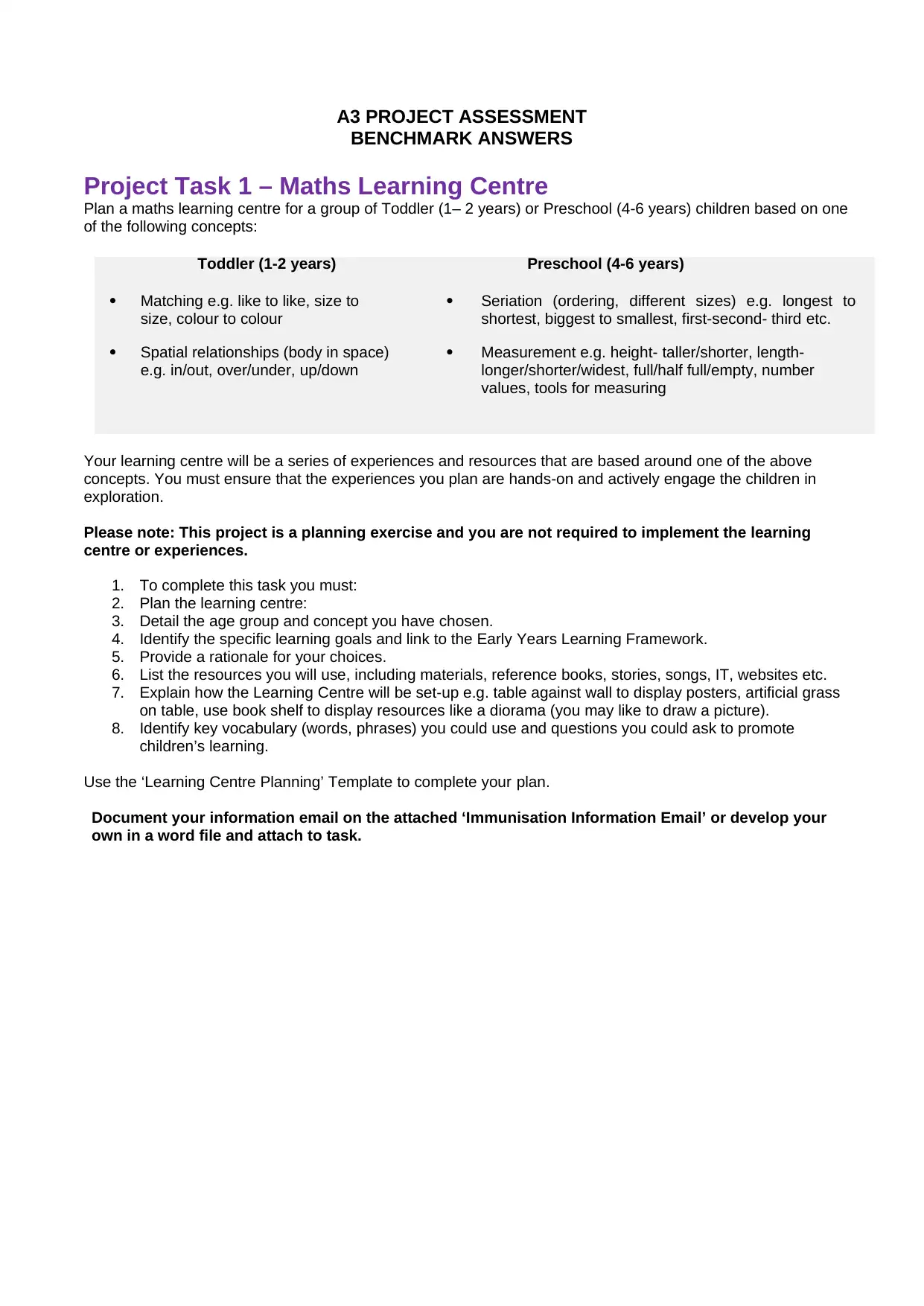
A3 PROJECT ASSESSMENT
BENCHMARK ANSWERS
Project Task 1 – Maths Learning Centre
Plan a maths learning centre for a group of Toddler (1– 2 years) or Preschool (4-6 years) children based on one
of the following concepts:
Toddler (1-2 years) Preschool (4-6 years)
Matching e.g. like to like, size to
size, colour to colour
Spatial relationships (body in space)
e.g. in/out, over/under, up/down
Seriation (ordering, different sizes) e.g. longest to
shortest, biggest to smallest, first-second- third etc.
Measurement e.g. height- taller/shorter, length-
longer/shorter/widest, full/half full/empty, number
values, tools for measuring
Your learning centre will be a series of experiences and resources that are based around one of the above
concepts. You must ensure that the experiences you plan are hands-on and actively engage the children in
exploration.
Please note: This project is a planning exercise and you are not required to implement the learning
centre or experiences.
1. To complete this task you must:
2. Plan the learning centre:
3. Detail the age group and concept you have chosen.
4. Identify the specific learning goals and link to the Early Years Learning Framework.
5. Provide a rationale for your choices.
6. List the resources you will use, including materials, reference books, stories, songs, IT, websites etc.
7. Explain how the Learning Centre will be set-up e.g. table against wall to display posters, artificial grass
on table, use book shelf to display resources like a diorama (you may like to draw a picture).
8. Identify key vocabulary (words, phrases) you could use and questions you could ask to promote
children’s learning.
Use the ‘Learning Centre Planning’ Template to complete your plan.
Document your information email on the attached ‘Immunisation Information Email’ or develop your
own in a word file and attach to task.
BENCHMARK ANSWERS
Project Task 1 – Maths Learning Centre
Plan a maths learning centre for a group of Toddler (1– 2 years) or Preschool (4-6 years) children based on one
of the following concepts:
Toddler (1-2 years) Preschool (4-6 years)
Matching e.g. like to like, size to
size, colour to colour
Spatial relationships (body in space)
e.g. in/out, over/under, up/down
Seriation (ordering, different sizes) e.g. longest to
shortest, biggest to smallest, first-second- third etc.
Measurement e.g. height- taller/shorter, length-
longer/shorter/widest, full/half full/empty, number
values, tools for measuring
Your learning centre will be a series of experiences and resources that are based around one of the above
concepts. You must ensure that the experiences you plan are hands-on and actively engage the children in
exploration.
Please note: This project is a planning exercise and you are not required to implement the learning
centre or experiences.
1. To complete this task you must:
2. Plan the learning centre:
3. Detail the age group and concept you have chosen.
4. Identify the specific learning goals and link to the Early Years Learning Framework.
5. Provide a rationale for your choices.
6. List the resources you will use, including materials, reference books, stories, songs, IT, websites etc.
7. Explain how the Learning Centre will be set-up e.g. table against wall to display posters, artificial grass
on table, use book shelf to display resources like a diorama (you may like to draw a picture).
8. Identify key vocabulary (words, phrases) you could use and questions you could ask to promote
children’s learning.
Use the ‘Learning Centre Planning’ Template to complete your plan.
Document your information email on the attached ‘Immunisation Information Email’ or develop your
own in a word file and attach to task.
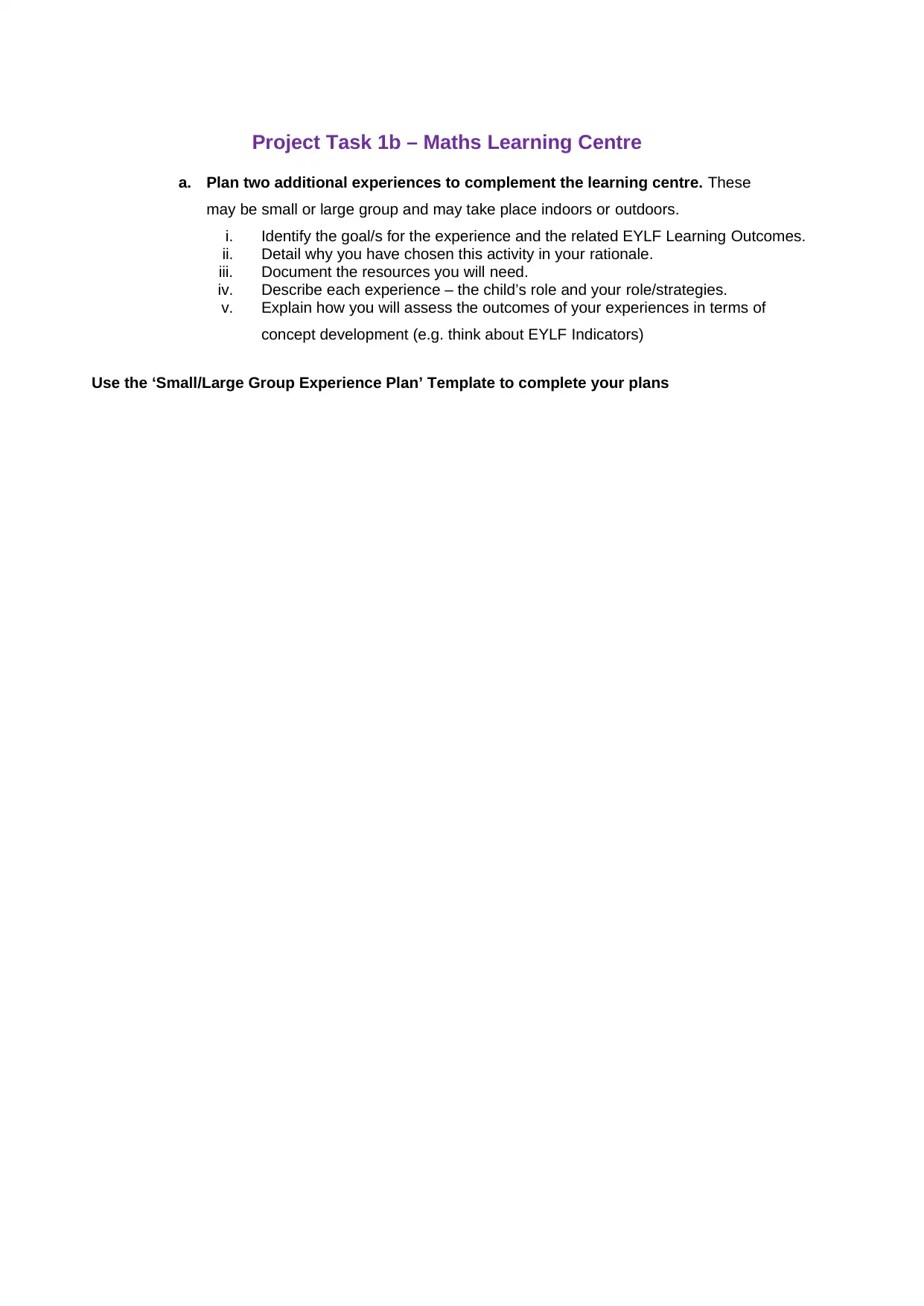
Project Task 1b – Maths Learning Centre
a. Plan two additional experiences to complement the learning centre. These
may be small or large group and may take place indoors or outdoors.
i. Identify the goal/s for the experience and the related EYLF Learning Outcomes.
ii. Detail why you have chosen this activity in your rationale.
iii. Document the resources you will need.
iv. Describe each experience – the child’s role and your role/strategies.
v. Explain how you will assess the outcomes of your experiences in terms of
concept development (e.g. think about EYLF Indicators)
Use the ‘Small/Large Group Experience Plan’ Template to complete your plans
a. Plan two additional experiences to complement the learning centre. These
may be small or large group and may take place indoors or outdoors.
i. Identify the goal/s for the experience and the related EYLF Learning Outcomes.
ii. Detail why you have chosen this activity in your rationale.
iii. Document the resources you will need.
iv. Describe each experience – the child’s role and your role/strategies.
v. Explain how you will assess the outcomes of your experiences in terms of
concept development (e.g. think about EYLF Indicators)
Use the ‘Small/Large Group Experience Plan’ Template to complete your plans
Secure Best Marks with AI Grader
Need help grading? Try our AI Grader for instant feedback on your assignments.
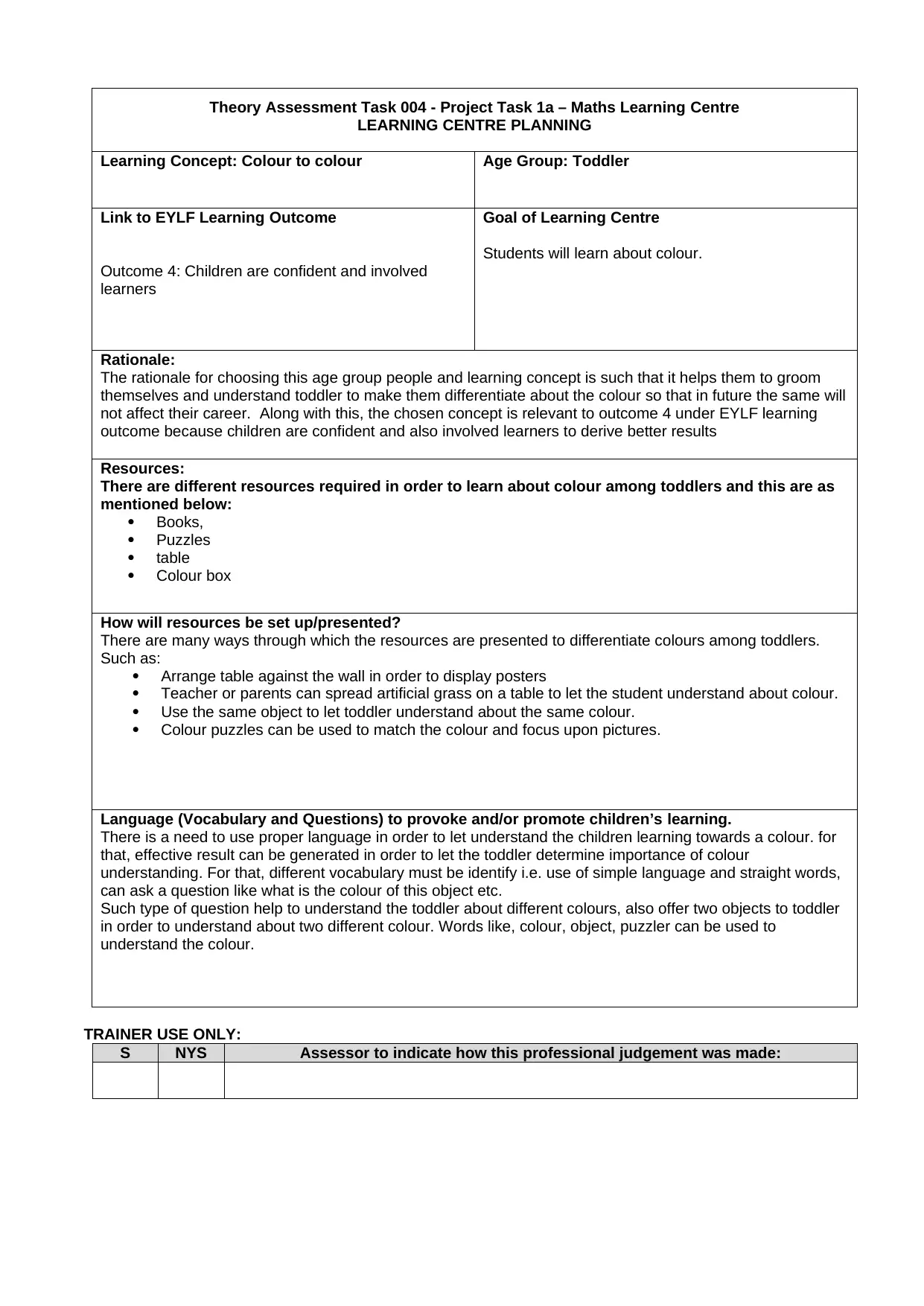
Theory Assessment Task 004 - Project Task 1a – Maths Learning Centre
LEARNING CENTRE PLANNING
Learning Concept: Colour to colour Age Group: Toddler
Link to EYLF Learning Outcome
Outcome 4: Children are confident and involved
learners
Goal of Learning Centre
Students will learn about colour.
Rationale:
The rationale for choosing this age group people and learning concept is such that it helps them to groom
themselves and understand toddler to make them differentiate about the colour so that in future the same will
not affect their career. Along with this, the chosen concept is relevant to outcome 4 under EYLF learning
outcome because children are confident and also involved learners to derive better results
Resources:
There are different resources required in order to learn about colour among toddlers and this are as
mentioned below:
Books,
Puzzles
table
Colour box
How will resources be set up/presented?
There are many ways through which the resources are presented to differentiate colours among toddlers.
Such as:
Arrange table against the wall in order to display posters
Teacher or parents can spread artificial grass on a table to let the student understand about colour.
Use the same object to let toddler understand about the same colour.
Colour puzzles can be used to match the colour and focus upon pictures.
Language (Vocabulary and Questions) to provoke and/or promote children’s learning.
There is a need to use proper language in order to let understand the children learning towards a colour. for
that, effective result can be generated in order to let the toddler determine importance of colour
understanding. For that, different vocabulary must be identify i.e. use of simple language and straight words,
can ask a question like what is the colour of this object etc.
Such type of question help to understand the toddler about different colours, also offer two objects to toddler
in order to understand about two different colour. Words like, colour, object, puzzler can be used to
understand the colour.
TRAINER USE ONLY:
S NYS Assessor to indicate how this professional judgement was made:
LEARNING CENTRE PLANNING
Learning Concept: Colour to colour Age Group: Toddler
Link to EYLF Learning Outcome
Outcome 4: Children are confident and involved
learners
Goal of Learning Centre
Students will learn about colour.
Rationale:
The rationale for choosing this age group people and learning concept is such that it helps them to groom
themselves and understand toddler to make them differentiate about the colour so that in future the same will
not affect their career. Along with this, the chosen concept is relevant to outcome 4 under EYLF learning
outcome because children are confident and also involved learners to derive better results
Resources:
There are different resources required in order to learn about colour among toddlers and this are as
mentioned below:
Books,
Puzzles
table
Colour box
How will resources be set up/presented?
There are many ways through which the resources are presented to differentiate colours among toddlers.
Such as:
Arrange table against the wall in order to display posters
Teacher or parents can spread artificial grass on a table to let the student understand about colour.
Use the same object to let toddler understand about the same colour.
Colour puzzles can be used to match the colour and focus upon pictures.
Language (Vocabulary and Questions) to provoke and/or promote children’s learning.
There is a need to use proper language in order to let understand the children learning towards a colour. for
that, effective result can be generated in order to let the toddler determine importance of colour
understanding. For that, different vocabulary must be identify i.e. use of simple language and straight words,
can ask a question like what is the colour of this object etc.
Such type of question help to understand the toddler about different colours, also offer two objects to toddler
in order to understand about two different colour. Words like, colour, object, puzzler can be used to
understand the colour.
TRAINER USE ONLY:
S NYS Assessor to indicate how this professional judgement was made:
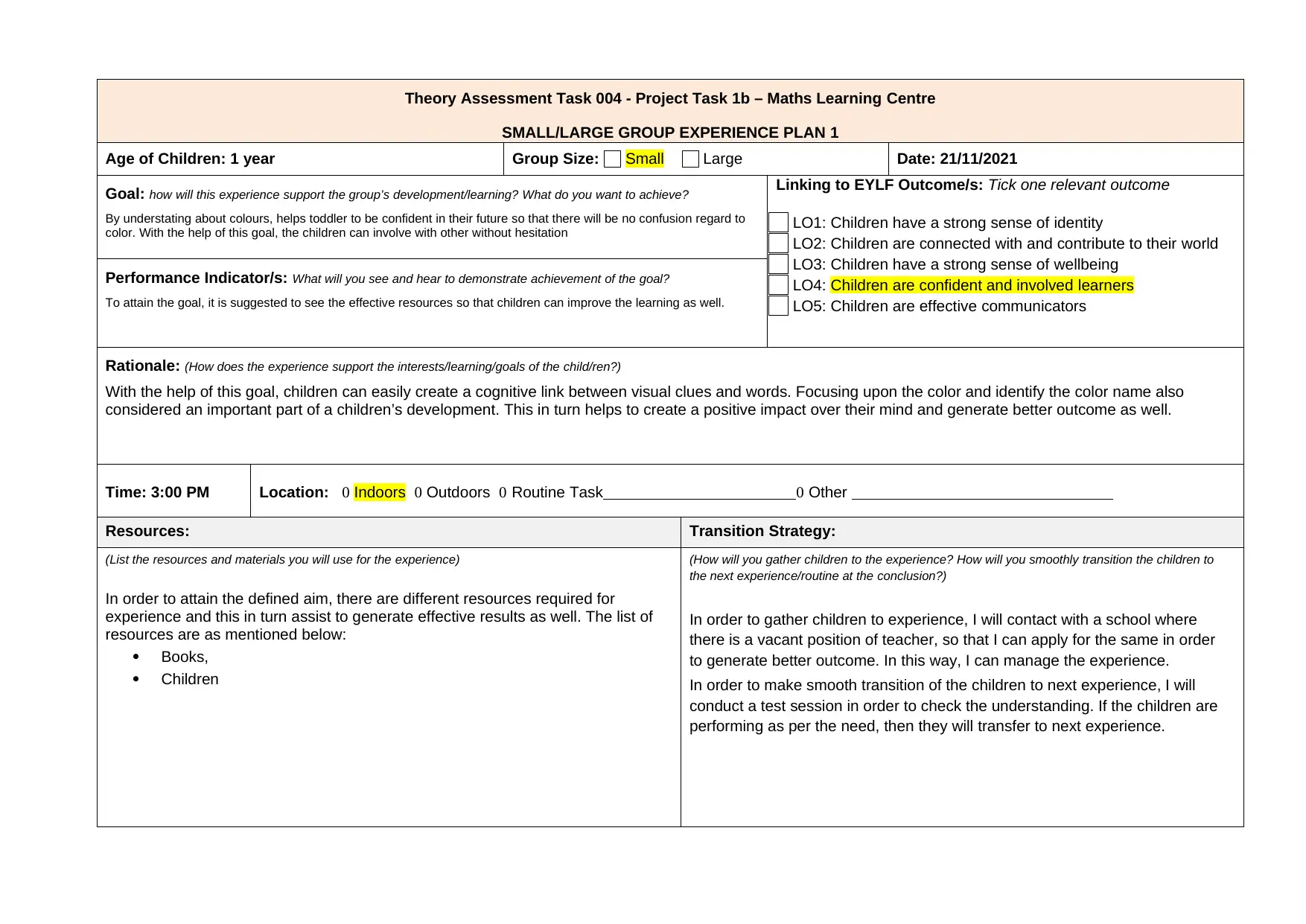
Theory Assessment Task 004 - Project Task 1b – Maths Learning Centre
SMALL/LARGE GROUP EXPERIENCE PLAN 1
Age of Children: 1 year Group Size: Small Large Date: 21/11/2021
Goal: how will this experience support the group’s development/learning? What do you want to achieve?
By understating about colours, helps toddler to be confident in their future so that there will be no confusion regard to
color. With the help of this goal, the children can involve with other without hesitation
Linking to EYLF Outcome/s: Tick one relevant outcome
LO1: Children have a strong sense of identity
LO2: Children are connected with and contribute to their world
LO3: Children have a strong sense of wellbeing
LO4: Children are confident and involved learners
LO5: Children are effective communicators
Performance Indicator/s: What will you see and hear to demonstrate achievement of the goal?
To attain the goal, it is suggested to see the effective resources so that children can improve the learning as well.
Rationale: (How does the experience support the interests/learning/goals of the child/ren?)
With the help of this goal, children can easily create a cognitive link between visual clues and words. Focusing upon the color and identify the color name also
considered an important part of a children’s development. This in turn helps to create a positive impact over their mind and generate better outcome as well.
Time: 3:00 PM Location: Indoors Outdoors Routine Task Other
Resources: Transition Strategy:
(List the resources and materials you will use for the experience)
In order to attain the defined aim, there are different resources required for
experience and this in turn assist to generate effective results as well. The list of
resources are as mentioned below:
Books,
Children
(How will you gather children to the experience? How will you smoothly transition the children to
the next experience/routine at the conclusion?)
In order to gather children to experience, I will contact with a school where
there is a vacant position of teacher, so that I can apply for the same in order
to generate better outcome. In this way, I can manage the experience.
In order to make smooth transition of the children to next experience, I will
conduct a test session in order to check the understanding. If the children are
performing as per the need, then they will transfer to next experience.
SMALL/LARGE GROUP EXPERIENCE PLAN 1
Age of Children: 1 year Group Size: Small Large Date: 21/11/2021
Goal: how will this experience support the group’s development/learning? What do you want to achieve?
By understating about colours, helps toddler to be confident in their future so that there will be no confusion regard to
color. With the help of this goal, the children can involve with other without hesitation
Linking to EYLF Outcome/s: Tick one relevant outcome
LO1: Children have a strong sense of identity
LO2: Children are connected with and contribute to their world
LO3: Children have a strong sense of wellbeing
LO4: Children are confident and involved learners
LO5: Children are effective communicators
Performance Indicator/s: What will you see and hear to demonstrate achievement of the goal?
To attain the goal, it is suggested to see the effective resources so that children can improve the learning as well.
Rationale: (How does the experience support the interests/learning/goals of the child/ren?)
With the help of this goal, children can easily create a cognitive link between visual clues and words. Focusing upon the color and identify the color name also
considered an important part of a children’s development. This in turn helps to create a positive impact over their mind and generate better outcome as well.
Time: 3:00 PM Location: Indoors Outdoors Routine Task Other
Resources: Transition Strategy:
(List the resources and materials you will use for the experience)
In order to attain the defined aim, there are different resources required for
experience and this in turn assist to generate effective results as well. The list of
resources are as mentioned below:
Books,
Children
(How will you gather children to the experience? How will you smoothly transition the children to
the next experience/routine at the conclusion?)
In order to gather children to experience, I will contact with a school where
there is a vacant position of teacher, so that I can apply for the same in order
to generate better outcome. In this way, I can manage the experience.
In order to make smooth transition of the children to next experience, I will
conduct a test session in order to check the understanding. If the children are
performing as per the need, then they will transfer to next experience.
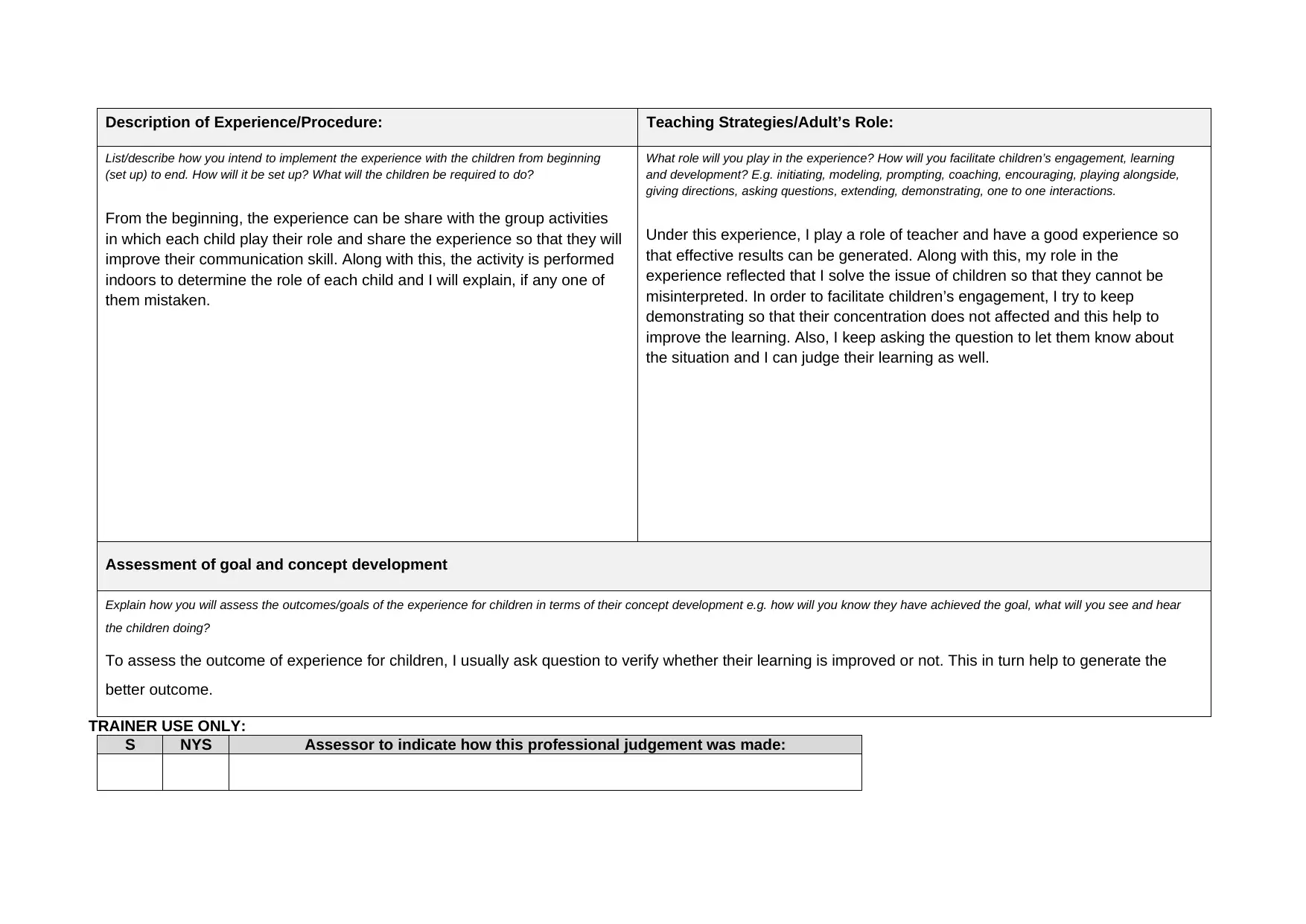
Description of Experience/Procedure: Teaching Strategies/Adult’s Role:
List/describe how you intend to implement the experience with the children from beginning
(set up) to end. How will it be set up? What will the children be required to do?
From the beginning, the experience can be share with the group activities
in which each child play their role and share the experience so that they will
improve their communication skill. Along with this, the activity is performed
indoors to determine the role of each child and I will explain, if any one of
them mistaken.
What role will you play in the experience? How will you facilitate children’s engagement, learning
and development? E.g. initiating, modeling, prompting, coaching, encouraging, playing alongside,
giving directions, asking questions, extending, demonstrating, one to one interactions.
Under this experience, I play a role of teacher and have a good experience so
that effective results can be generated. Along with this, my role in the
experience reflected that I solve the issue of children so that they cannot be
misinterpreted. In order to facilitate children’s engagement, I try to keep
demonstrating so that their concentration does not affected and this help to
improve the learning. Also, I keep asking the question to let them know about
the situation and I can judge their learning as well.
Assessment of goal and concept development
Explain how you will assess the outcomes/goals of the experience for children in terms of their concept development e.g. how will you know they have achieved the goal, what will you see and hear
the children doing?
To assess the outcome of experience for children, I usually ask question to verify whether their learning is improved or not. This in turn help to generate the
better outcome.
TRAINER USE ONLY:
S NYS Assessor to indicate how this professional judgement was made:
List/describe how you intend to implement the experience with the children from beginning
(set up) to end. How will it be set up? What will the children be required to do?
From the beginning, the experience can be share with the group activities
in which each child play their role and share the experience so that they will
improve their communication skill. Along with this, the activity is performed
indoors to determine the role of each child and I will explain, if any one of
them mistaken.
What role will you play in the experience? How will you facilitate children’s engagement, learning
and development? E.g. initiating, modeling, prompting, coaching, encouraging, playing alongside,
giving directions, asking questions, extending, demonstrating, one to one interactions.
Under this experience, I play a role of teacher and have a good experience so
that effective results can be generated. Along with this, my role in the
experience reflected that I solve the issue of children so that they cannot be
misinterpreted. In order to facilitate children’s engagement, I try to keep
demonstrating so that their concentration does not affected and this help to
improve the learning. Also, I keep asking the question to let them know about
the situation and I can judge their learning as well.
Assessment of goal and concept development
Explain how you will assess the outcomes/goals of the experience for children in terms of their concept development e.g. how will you know they have achieved the goal, what will you see and hear
the children doing?
To assess the outcome of experience for children, I usually ask question to verify whether their learning is improved or not. This in turn help to generate the
better outcome.
TRAINER USE ONLY:
S NYS Assessor to indicate how this professional judgement was made:
Paraphrase This Document
Need a fresh take? Get an instant paraphrase of this document with our AI Paraphraser
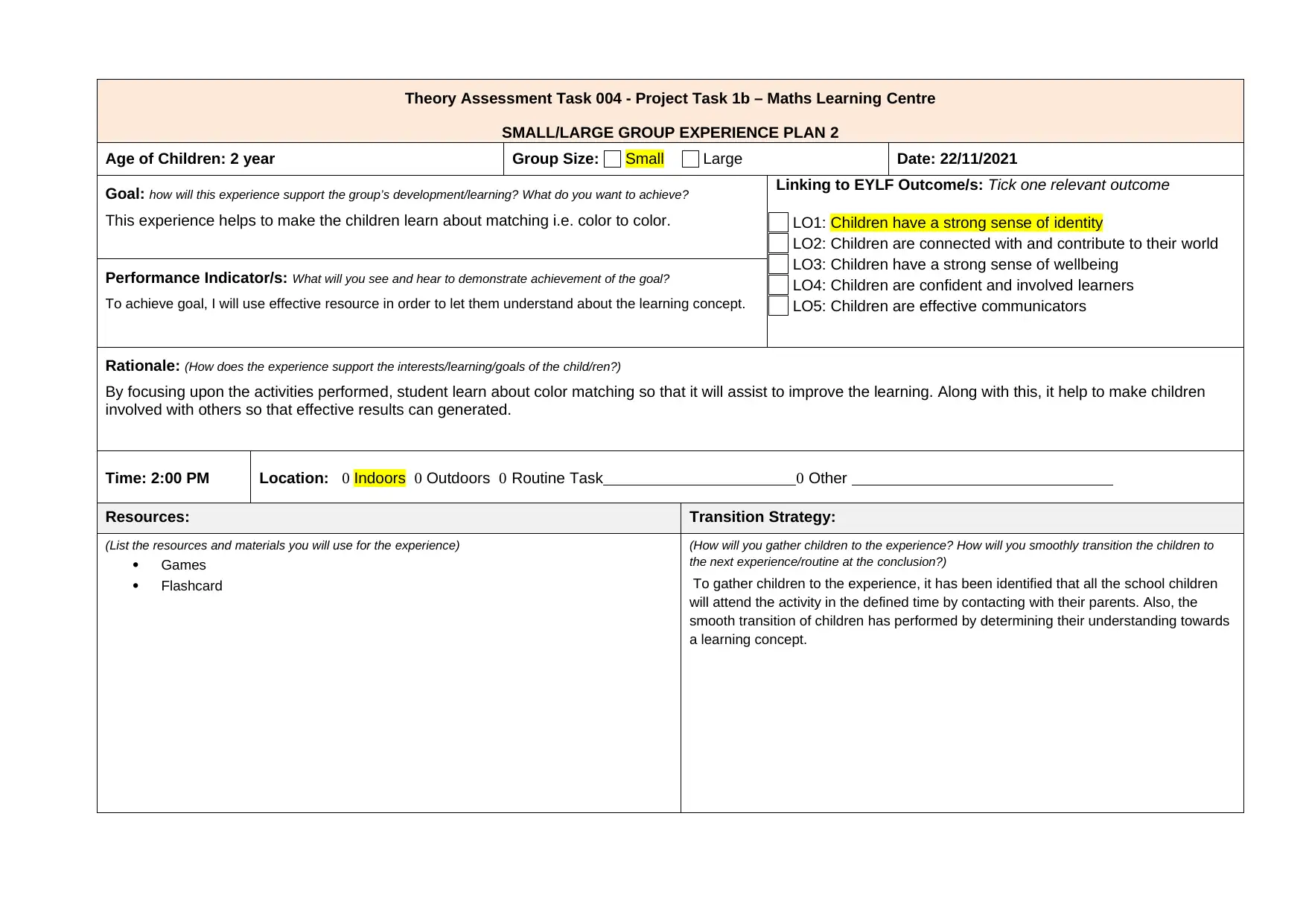
Theory Assessment Task 004 - Project Task 1b – Maths Learning Centre
SMALL/LARGE GROUP EXPERIENCE PLAN 2
Age of Children: 2 year Group Size: Small Large Date: 22/11/2021
Goal: how will this experience support the group’s development/learning? What do you want to achieve?
This experience helps to make the children learn about matching i.e. color to color.
Linking to EYLF Outcome/s: Tick one relevant outcome
LO1: Children have a strong sense of identity
LO2: Children are connected with and contribute to their world
LO3: Children have a strong sense of wellbeing
LO4: Children are confident and involved learners
LO5: Children are effective communicators
Performance Indicator/s: What will you see and hear to demonstrate achievement of the goal?
To achieve goal, I will use effective resource in order to let them understand about the learning concept.
Rationale: (How does the experience support the interests/learning/goals of the child/ren?)
By focusing upon the activities performed, student learn about color matching so that it will assist to improve the learning. Along with this, it help to make children
involved with others so that effective results can generated.
Time: 2:00 PM Location: Indoors Outdoors Routine Task Other
Resources: Transition Strategy:
(List the resources and materials you will use for the experience)
Games
Flashcard
(How will you gather children to the experience? How will you smoothly transition the children to
the next experience/routine at the conclusion?)
To gather children to the experience, it has been identified that all the school children
will attend the activity in the defined time by contacting with their parents. Also, the
smooth transition of children has performed by determining their understanding towards
a learning concept.
SMALL/LARGE GROUP EXPERIENCE PLAN 2
Age of Children: 2 year Group Size: Small Large Date: 22/11/2021
Goal: how will this experience support the group’s development/learning? What do you want to achieve?
This experience helps to make the children learn about matching i.e. color to color.
Linking to EYLF Outcome/s: Tick one relevant outcome
LO1: Children have a strong sense of identity
LO2: Children are connected with and contribute to their world
LO3: Children have a strong sense of wellbeing
LO4: Children are confident and involved learners
LO5: Children are effective communicators
Performance Indicator/s: What will you see and hear to demonstrate achievement of the goal?
To achieve goal, I will use effective resource in order to let them understand about the learning concept.
Rationale: (How does the experience support the interests/learning/goals of the child/ren?)
By focusing upon the activities performed, student learn about color matching so that it will assist to improve the learning. Along with this, it help to make children
involved with others so that effective results can generated.
Time: 2:00 PM Location: Indoors Outdoors Routine Task Other
Resources: Transition Strategy:
(List the resources and materials you will use for the experience)
Games
Flashcard
(How will you gather children to the experience? How will you smoothly transition the children to
the next experience/routine at the conclusion?)
To gather children to the experience, it has been identified that all the school children
will attend the activity in the defined time by contacting with their parents. Also, the
smooth transition of children has performed by determining their understanding towards
a learning concept.
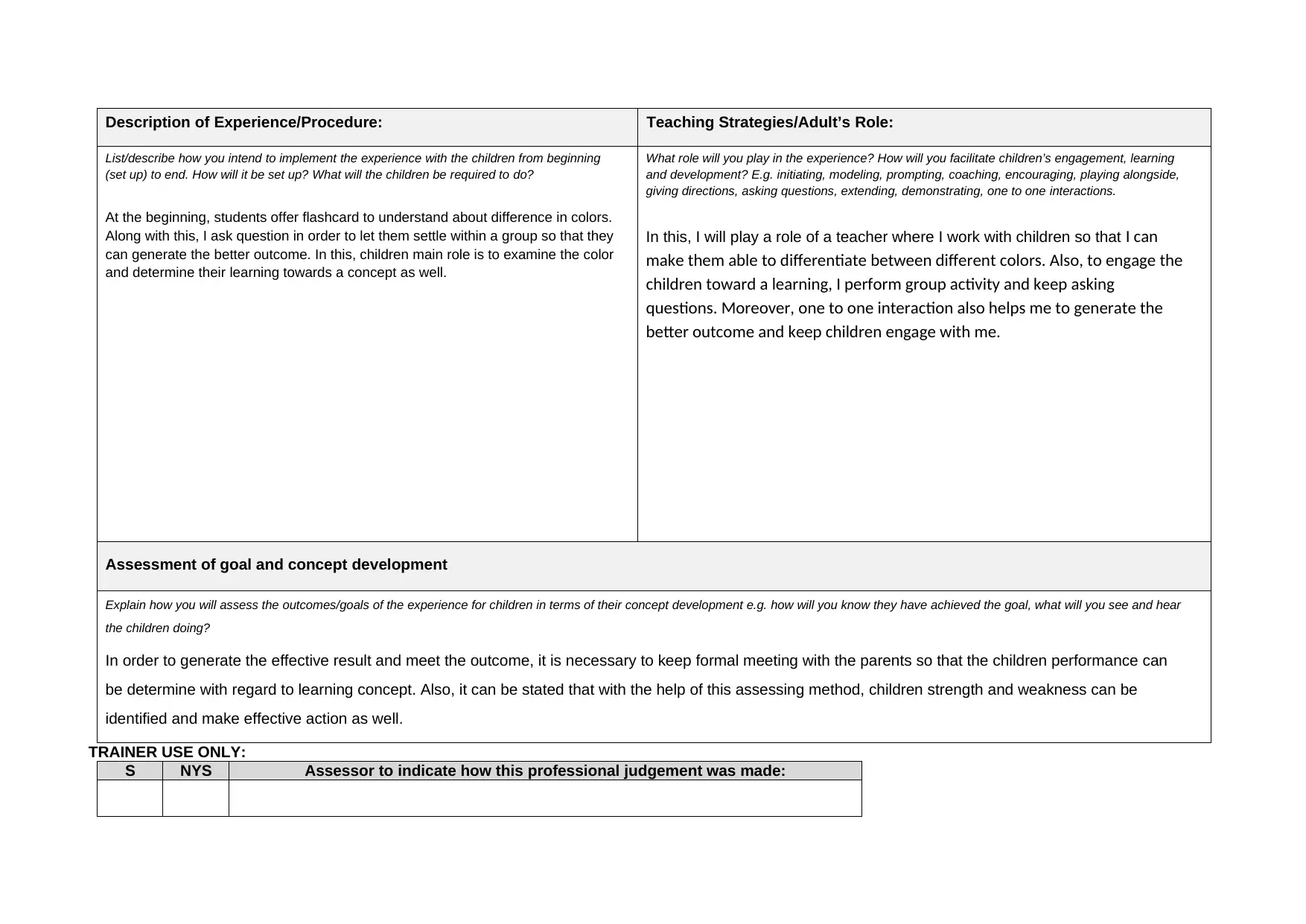
Description of Experience/Procedure: Teaching Strategies/Adult’s Role:
List/describe how you intend to implement the experience with the children from beginning
(set up) to end. How will it be set up? What will the children be required to do?
At the beginning, students offer flashcard to understand about difference in colors.
Along with this, I ask question in order to let them settle within a group so that they
can generate the better outcome. In this, children main role is to examine the color
and determine their learning towards a concept as well.
What role will you play in the experience? How will you facilitate children’s engagement, learning
and development? E.g. initiating, modeling, prompting, coaching, encouraging, playing alongside,
giving directions, asking questions, extending, demonstrating, one to one interactions.
In this, I will play a role of a teacher where I work with children so that I can
make them able to differentiate between different colors. Also, to engage the
children toward a learning, I perform group activity and keep asking
questions. Moreover, one to one interaction also helps me to generate the
better outcome and keep children engage with me.
Assessment of goal and concept development
Explain how you will assess the outcomes/goals of the experience for children in terms of their concept development e.g. how will you know they have achieved the goal, what will you see and hear
the children doing?
In order to generate the effective result and meet the outcome, it is necessary to keep formal meeting with the parents so that the children performance can
be determine with regard to learning concept. Also, it can be stated that with the help of this assessing method, children strength and weakness can be
identified and make effective action as well.
TRAINER USE ONLY:
S NYS Assessor to indicate how this professional judgement was made:
List/describe how you intend to implement the experience with the children from beginning
(set up) to end. How will it be set up? What will the children be required to do?
At the beginning, students offer flashcard to understand about difference in colors.
Along with this, I ask question in order to let them settle within a group so that they
can generate the better outcome. In this, children main role is to examine the color
and determine their learning towards a concept as well.
What role will you play in the experience? How will you facilitate children’s engagement, learning
and development? E.g. initiating, modeling, prompting, coaching, encouraging, playing alongside,
giving directions, asking questions, extending, demonstrating, one to one interactions.
In this, I will play a role of a teacher where I work with children so that I can
make them able to differentiate between different colors. Also, to engage the
children toward a learning, I perform group activity and keep asking
questions. Moreover, one to one interaction also helps me to generate the
better outcome and keep children engage with me.
Assessment of goal and concept development
Explain how you will assess the outcomes/goals of the experience for children in terms of their concept development e.g. how will you know they have achieved the goal, what will you see and hear
the children doing?
In order to generate the effective result and meet the outcome, it is necessary to keep formal meeting with the parents so that the children performance can
be determine with regard to learning concept. Also, it can be stated that with the help of this assessing method, children strength and weakness can be
identified and make effective action as well.
TRAINER USE ONLY:
S NYS Assessor to indicate how this professional judgement was made:

Secure Best Marks with AI Grader
Need help grading? Try our AI Grader for instant feedback on your assignments.
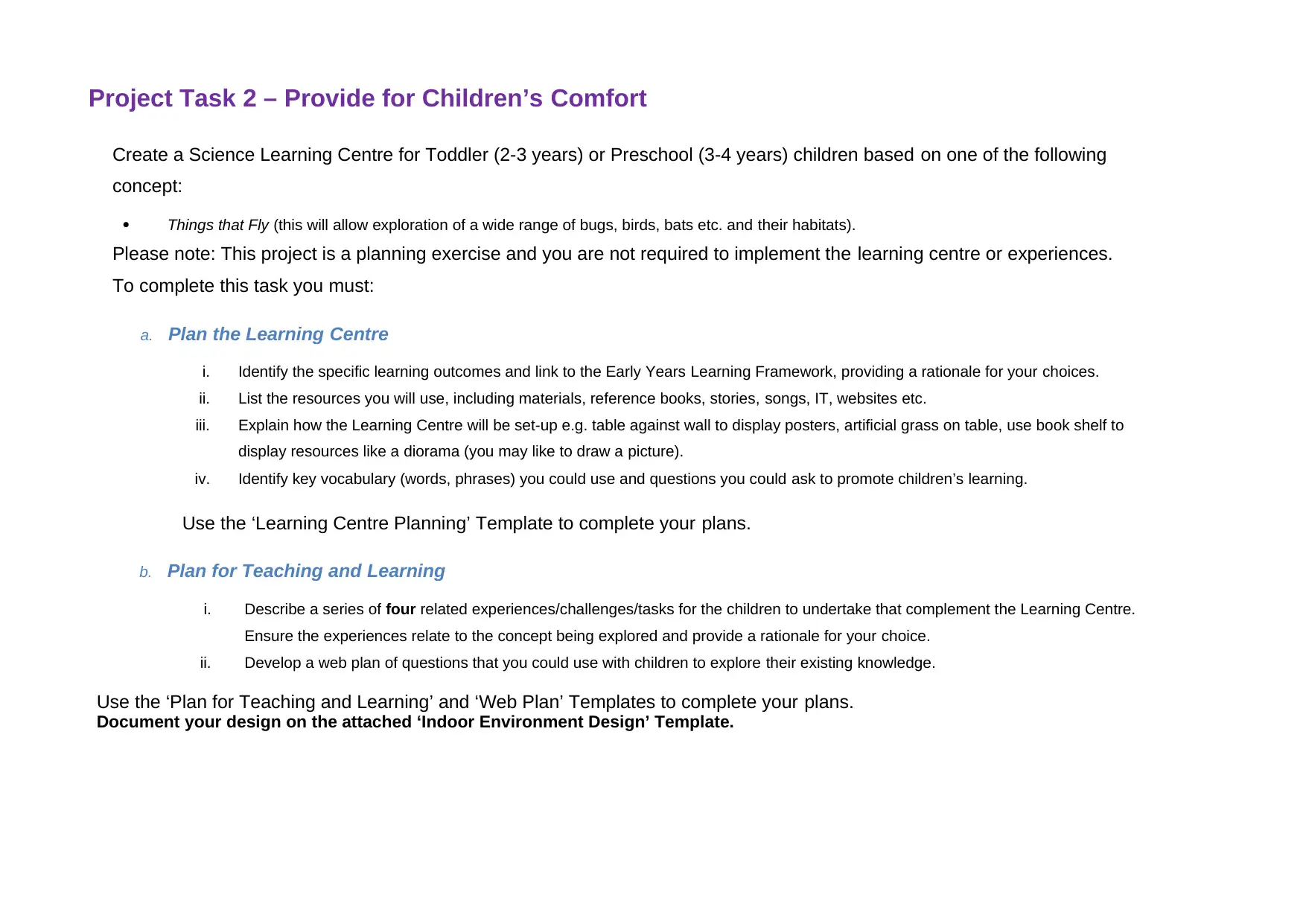
Project Task 2 – Provide for Children’s Comfort
Create a Science Learning Centre for Toddler (2-3 years) or Preschool (3-4 years) children based on one of the following
concept:
Things that Fly (this will allow exploration of a wide range of bugs, birds, bats etc. and their habitats).
Please note: This project is a planning exercise and you are not required to implement the learning centre or experiences.
To complete this task you must:
a. Plan the Learning Centre
i. Identify the specific learning outcomes and link to the Early Years Learning Framework, providing a rationale for your choices.
ii. List the resources you will use, including materials, reference books, stories, songs, IT, websites etc.
iii. Explain how the Learning Centre will be set-up e.g. table against wall to display posters, artificial grass on table, use book shelf to
display resources like a diorama (you may like to draw a picture).
iv. Identify key vocabulary (words, phrases) you could use and questions you could ask to promote children’s learning.
Use the ‘Learning Centre Planning’ Template to complete your plans.
b. Plan for Teaching and Learning
i. Describe a series of four related experiences/challenges/tasks for the children to undertake that complement the Learning Centre.
Ensure the experiences relate to the concept being explored and provide a rationale for your choice.
ii. Develop a web plan of questions that you could use with children to explore their existing knowledge.
Use the ‘Plan for Teaching and Learning’ and ‘Web Plan’ Templates to complete your plans.
Document your design on the attached ‘Indoor Environment Design’ Template.
Create a Science Learning Centre for Toddler (2-3 years) or Preschool (3-4 years) children based on one of the following
concept:
Things that Fly (this will allow exploration of a wide range of bugs, birds, bats etc. and their habitats).
Please note: This project is a planning exercise and you are not required to implement the learning centre or experiences.
To complete this task you must:
a. Plan the Learning Centre
i. Identify the specific learning outcomes and link to the Early Years Learning Framework, providing a rationale for your choices.
ii. List the resources you will use, including materials, reference books, stories, songs, IT, websites etc.
iii. Explain how the Learning Centre will be set-up e.g. table against wall to display posters, artificial grass on table, use book shelf to
display resources like a diorama (you may like to draw a picture).
iv. Identify key vocabulary (words, phrases) you could use and questions you could ask to promote children’s learning.
Use the ‘Learning Centre Planning’ Template to complete your plans.
b. Plan for Teaching and Learning
i. Describe a series of four related experiences/challenges/tasks for the children to undertake that complement the Learning Centre.
Ensure the experiences relate to the concept being explored and provide a rationale for your choice.
ii. Develop a web plan of questions that you could use with children to explore their existing knowledge.
Use the ‘Plan for Teaching and Learning’ and ‘Web Plan’ Templates to complete your plans.
Document your design on the attached ‘Indoor Environment Design’ Template.
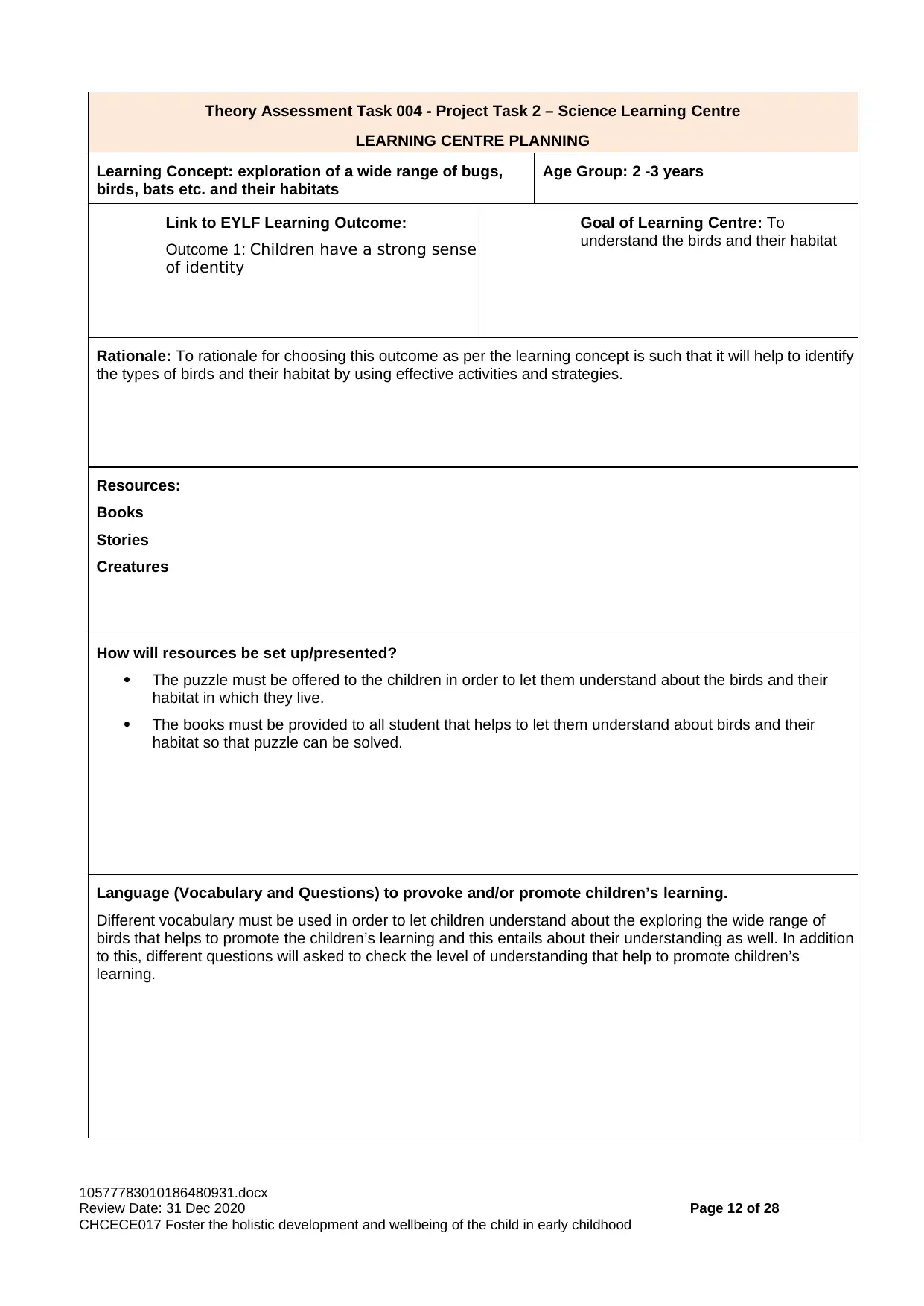
Theory Assessment Task 004 - Project Task 2 – Science Learning Centre
LEARNING CENTRE PLANNING
Learning Concept: exploration of a wide range of bugs,
birds, bats etc. and their habitats
Age Group: 2 -3 years
Link to EYLF Learning Outcome:
Outcome 1: Children have a strong sense
of identity
Goal of Learning Centre: To
understand the birds and their habitat
Rationale: To rationale for choosing this outcome as per the learning concept is such that it will help to identify
the types of birds and their habitat by using effective activities and strategies.
Resources:
Books
Stories
Creatures
How will resources be set up/presented?
The puzzle must be offered to the children in order to let them understand about the birds and their
habitat in which they live.
The books must be provided to all student that helps to let them understand about birds and their
habitat so that puzzle can be solved.
Language (Vocabulary and Questions) to provoke and/or promote children’s learning.
Different vocabulary must be used in order to let children understand about the exploring the wide range of
birds that helps to promote the children’s learning and this entails about their understanding as well. In addition
to this, different questions will asked to check the level of understanding that help to promote children’s
learning.
10577783010186480931.docx
Review Date: 31 Dec 2020 Page 12 of 28
CHCECE017 Foster the holistic development and wellbeing of the child in early childhood
LEARNING CENTRE PLANNING
Learning Concept: exploration of a wide range of bugs,
birds, bats etc. and their habitats
Age Group: 2 -3 years
Link to EYLF Learning Outcome:
Outcome 1: Children have a strong sense
of identity
Goal of Learning Centre: To
understand the birds and their habitat
Rationale: To rationale for choosing this outcome as per the learning concept is such that it will help to identify
the types of birds and their habitat by using effective activities and strategies.
Resources:
Books
Stories
Creatures
How will resources be set up/presented?
The puzzle must be offered to the children in order to let them understand about the birds and their
habitat in which they live.
The books must be provided to all student that helps to let them understand about birds and their
habitat so that puzzle can be solved.
Language (Vocabulary and Questions) to provoke and/or promote children’s learning.
Different vocabulary must be used in order to let children understand about the exploring the wide range of
birds that helps to promote the children’s learning and this entails about their understanding as well. In addition
to this, different questions will asked to check the level of understanding that help to promote children’s
learning.
10577783010186480931.docx
Review Date: 31 Dec 2020 Page 12 of 28
CHCECE017 Foster the holistic development and wellbeing of the child in early childhood
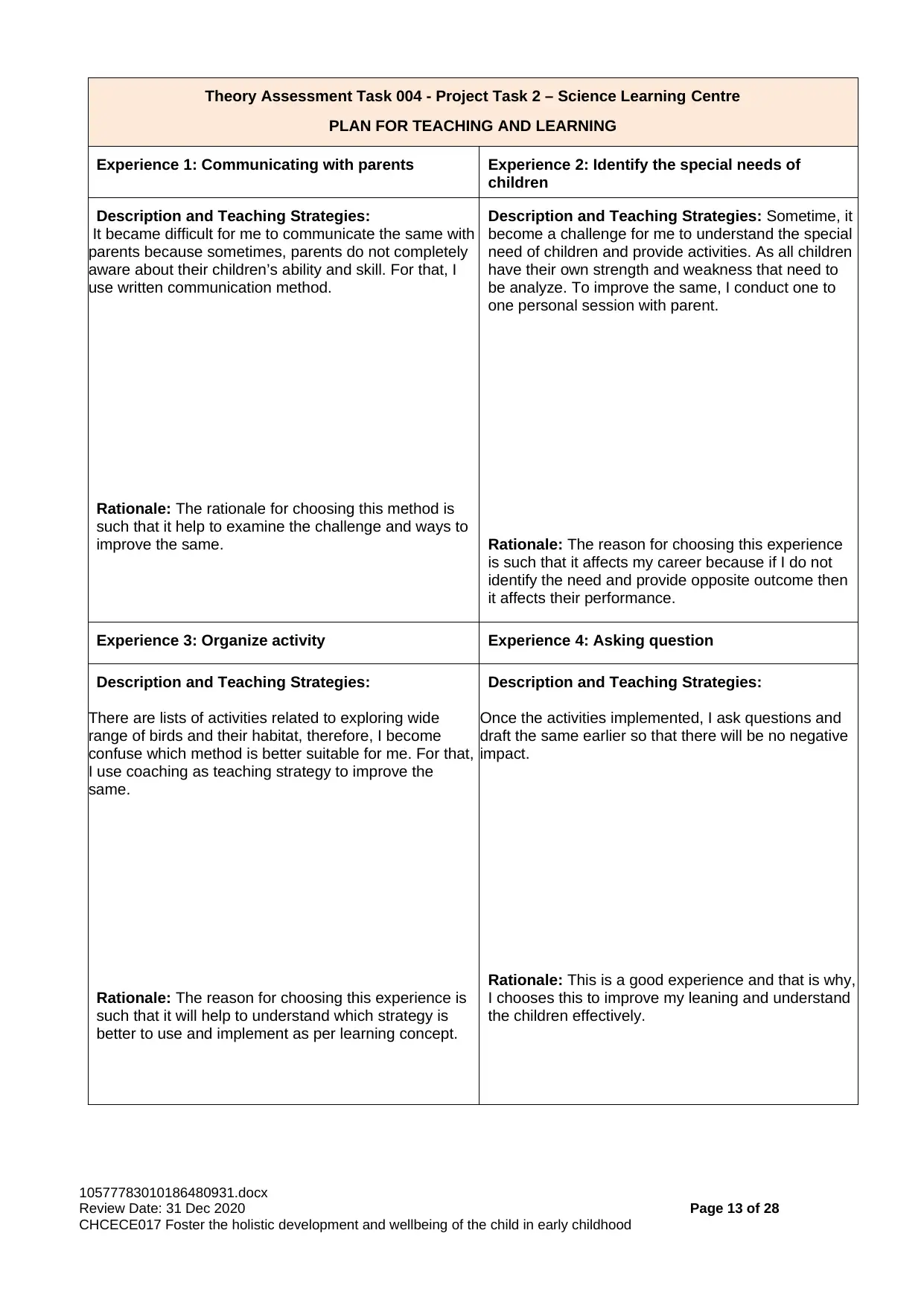
Theory Assessment Task 004 - Project Task 2 – Science Learning Centre
PLAN FOR TEACHING AND LEARNING
Experience 1: Communicating with parents Experience 2: Identify the special needs of
children
Description and Teaching Strategies:
It became difficult for me to communicate the same with
parents because sometimes, parents do not completely
aware about their children’s ability and skill. For that, I
use written communication method.
Rationale: The rationale for choosing this method is
such that it help to examine the challenge and ways to
improve the same.
Description and Teaching Strategies: Sometime, it
become a challenge for me to understand the special
need of children and provide activities. As all children
have their own strength and weakness that need to
be analyze. To improve the same, I conduct one to
one personal session with parent.
Rationale: The reason for choosing this experience
is such that it affects my career because if I do not
identify the need and provide opposite outcome then
it affects their performance.
Experience 3: Organize activity Experience 4: Asking question
Description and Teaching Strategies:
There are lists of activities related to exploring wide
range of birds and their habitat, therefore, I become
confuse which method is better suitable for me. For that,
I use coaching as teaching strategy to improve the
same.
Rationale: The reason for choosing this experience is
such that it will help to understand which strategy is
better to use and implement as per learning concept.
Description and Teaching Strategies:
Once the activities implemented, I ask questions and
draft the same earlier so that there will be no negative
impact.
Rationale: This is a good experience and that is why,
I chooses this to improve my leaning and understand
the children effectively.
10577783010186480931.docx
Review Date: 31 Dec 2020 Page 13 of 28
CHCECE017 Foster the holistic development and wellbeing of the child in early childhood
PLAN FOR TEACHING AND LEARNING
Experience 1: Communicating with parents Experience 2: Identify the special needs of
children
Description and Teaching Strategies:
It became difficult for me to communicate the same with
parents because sometimes, parents do not completely
aware about their children’s ability and skill. For that, I
use written communication method.
Rationale: The rationale for choosing this method is
such that it help to examine the challenge and ways to
improve the same.
Description and Teaching Strategies: Sometime, it
become a challenge for me to understand the special
need of children and provide activities. As all children
have their own strength and weakness that need to
be analyze. To improve the same, I conduct one to
one personal session with parent.
Rationale: The reason for choosing this experience
is such that it affects my career because if I do not
identify the need and provide opposite outcome then
it affects their performance.
Experience 3: Organize activity Experience 4: Asking question
Description and Teaching Strategies:
There are lists of activities related to exploring wide
range of birds and their habitat, therefore, I become
confuse which method is better suitable for me. For that,
I use coaching as teaching strategy to improve the
same.
Rationale: The reason for choosing this experience is
such that it will help to understand which strategy is
better to use and implement as per learning concept.
Description and Teaching Strategies:
Once the activities implemented, I ask questions and
draft the same earlier so that there will be no negative
impact.
Rationale: This is a good experience and that is why,
I chooses this to improve my leaning and understand
the children effectively.
10577783010186480931.docx
Review Date: 31 Dec 2020 Page 13 of 28
CHCECE017 Foster the holistic development and wellbeing of the child in early childhood
Paraphrase This Document
Need a fresh take? Get an instant paraphrase of this document with our AI Paraphraser
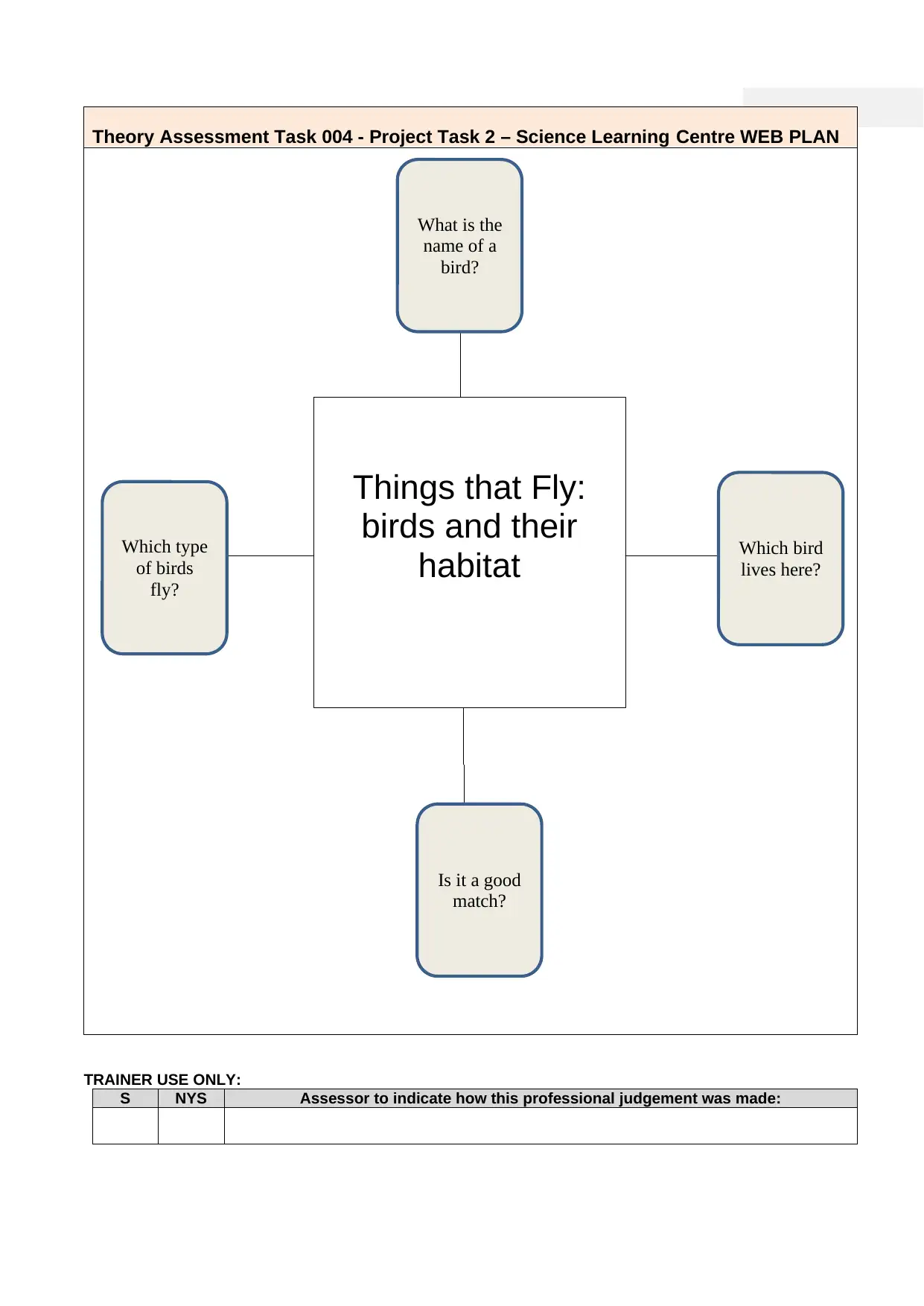
Theory Assessment Task 004 - Project Task 2 – Science Learning Centre WEB PLAN
TRAINER USE ONLY:
S NYS Assessor to indicate how this professional judgement was made:
Things that Fly:
birds and their
habitat
Which type
of birds
fly?
What is the
name of a
bird?
Which bird
lives here?
Is it a good
match?
TRAINER USE ONLY:
S NYS Assessor to indicate how this professional judgement was made:
Things that Fly:
birds and their
habitat
Which type
of birds
fly?
What is the
name of a
bird?
Which bird
lives here?
Is it a good
match?
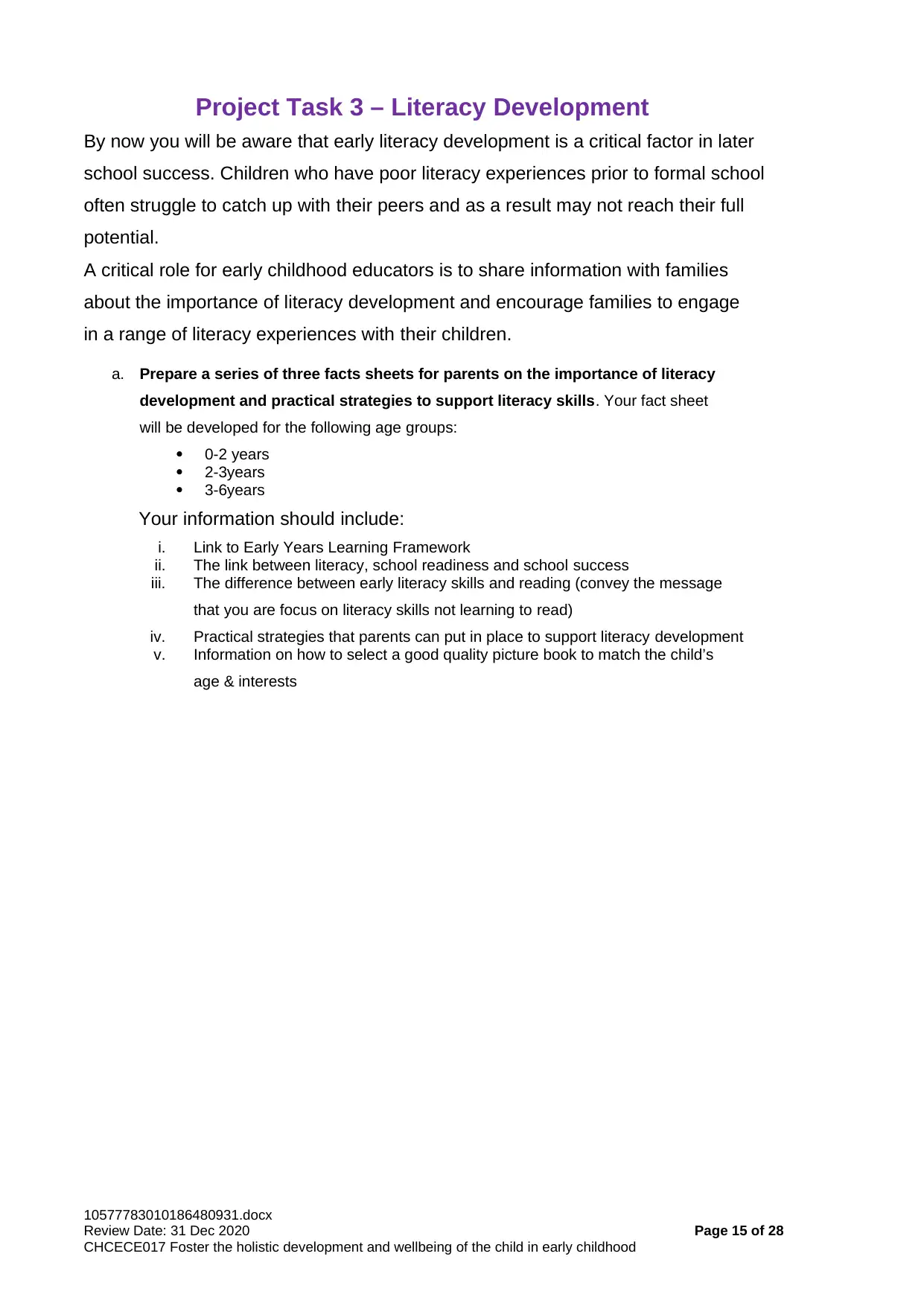
Project Task 3 – Literacy Development
By now you will be aware that early literacy development is a critical factor in later
school success. Children who have poor literacy experiences prior to formal school
often struggle to catch up with their peers and as a result may not reach their full
potential.
A critical role for early childhood educators is to share information with families
about the importance of literacy development and encourage families to engage
in a range of literacy experiences with their children.
a. Prepare a series of three facts sheets for parents on the importance of literacy
development and practical strategies to support literacy skills. Your fact sheet
will be developed for the following age groups:
0-2 years
2-3years
3-6years
Your information should include:
i. Link to Early Years Learning Framework
ii. The link between literacy, school readiness and school success
iii. The difference between early literacy skills and reading (convey the message
that you are focus on literacy skills not learning to read)
iv. Practical strategies that parents can put in place to support literacy development
v. Information on how to select a good quality picture book to match the child’s
age & interests
10577783010186480931.docx
Review Date: 31 Dec 2020 Page 15 of 28
CHCECE017 Foster the holistic development and wellbeing of the child in early childhood
By now you will be aware that early literacy development is a critical factor in later
school success. Children who have poor literacy experiences prior to formal school
often struggle to catch up with their peers and as a result may not reach their full
potential.
A critical role for early childhood educators is to share information with families
about the importance of literacy development and encourage families to engage
in a range of literacy experiences with their children.
a. Prepare a series of three facts sheets for parents on the importance of literacy
development and practical strategies to support literacy skills. Your fact sheet
will be developed for the following age groups:
0-2 years
2-3years
3-6years
Your information should include:
i. Link to Early Years Learning Framework
ii. The link between literacy, school readiness and school success
iii. The difference between early literacy skills and reading (convey the message
that you are focus on literacy skills not learning to read)
iv. Practical strategies that parents can put in place to support literacy development
v. Information on how to select a good quality picture book to match the child’s
age & interests
10577783010186480931.docx
Review Date: 31 Dec 2020 Page 15 of 28
CHCECE017 Foster the holistic development and wellbeing of the child in early childhood
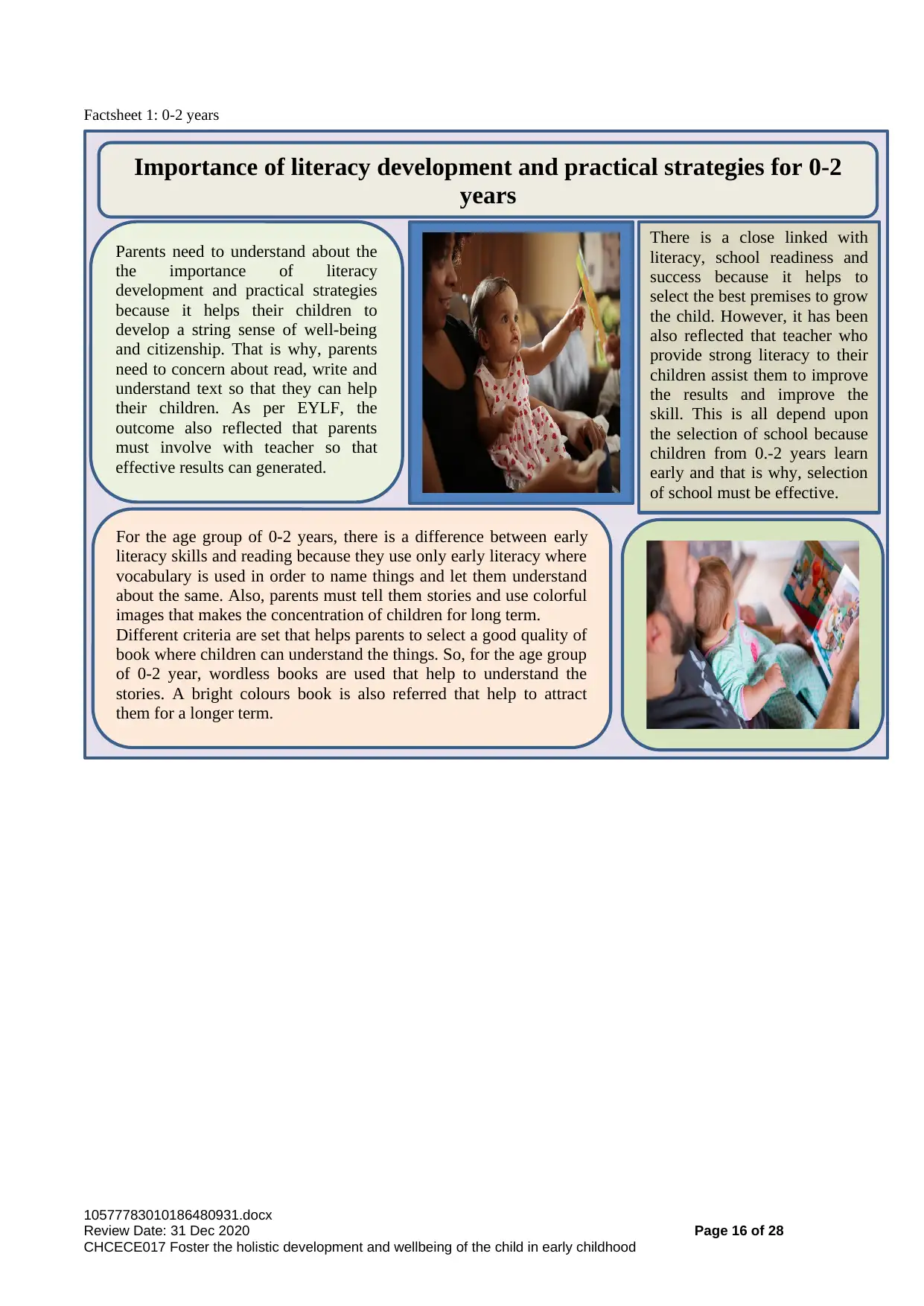
Factsheet 1: 0-2 years
10577783010186480931.docx
Review Date: 31 Dec 2020 Page 16 of 28
CHCECE017 Foster the holistic development and wellbeing of the child in early childhood
Importance of literacy development and practical strategies for 0-2
years
Parents need to understand about the
the importance of literacy
development and practical strategies
because it helps their children to
develop a string sense of well-being
and citizenship. That is why, parents
need to concern about read, write and
understand text so that they can help
their children. As per EYLF, the
outcome also reflected that parents
must involve with teacher so that
effective results can generated.
There is a close linked with
literacy, school readiness and
success because it helps to
select the best premises to grow
the child. However, it has been
also reflected that teacher who
provide strong literacy to their
children assist them to improve
the results and improve the
skill. This is all depend upon
the selection of school because
children from 0.-2 years learn
early and that is why, selection
of school must be effective.
For the age group of 0-2 years, there is a difference between early
literacy skills and reading because they use only early literacy where
vocabulary is used in order to name things and let them understand
about the same. Also, parents must tell them stories and use colorful
images that makes the concentration of children for long term.
Different criteria are set that helps parents to select a good quality of
book where children can understand the things. So, for the age group
of 0-2 year, wordless books are used that help to understand the
stories. A bright colours book is also referred that help to attract
them for a longer term.
10577783010186480931.docx
Review Date: 31 Dec 2020 Page 16 of 28
CHCECE017 Foster the holistic development and wellbeing of the child in early childhood
Importance of literacy development and practical strategies for 0-2
years
Parents need to understand about the
the importance of literacy
development and practical strategies
because it helps their children to
develop a string sense of well-being
and citizenship. That is why, parents
need to concern about read, write and
understand text so that they can help
their children. As per EYLF, the
outcome also reflected that parents
must involve with teacher so that
effective results can generated.
There is a close linked with
literacy, school readiness and
success because it helps to
select the best premises to grow
the child. However, it has been
also reflected that teacher who
provide strong literacy to their
children assist them to improve
the results and improve the
skill. This is all depend upon
the selection of school because
children from 0.-2 years learn
early and that is why, selection
of school must be effective.
For the age group of 0-2 years, there is a difference between early
literacy skills and reading because they use only early literacy where
vocabulary is used in order to name things and let them understand
about the same. Also, parents must tell them stories and use colorful
images that makes the concentration of children for long term.
Different criteria are set that helps parents to select a good quality of
book where children can understand the things. So, for the age group
of 0-2 year, wordless books are used that help to understand the
stories. A bright colours book is also referred that help to attract
them for a longer term.
Secure Best Marks with AI Grader
Need help grading? Try our AI Grader for instant feedback on your assignments.
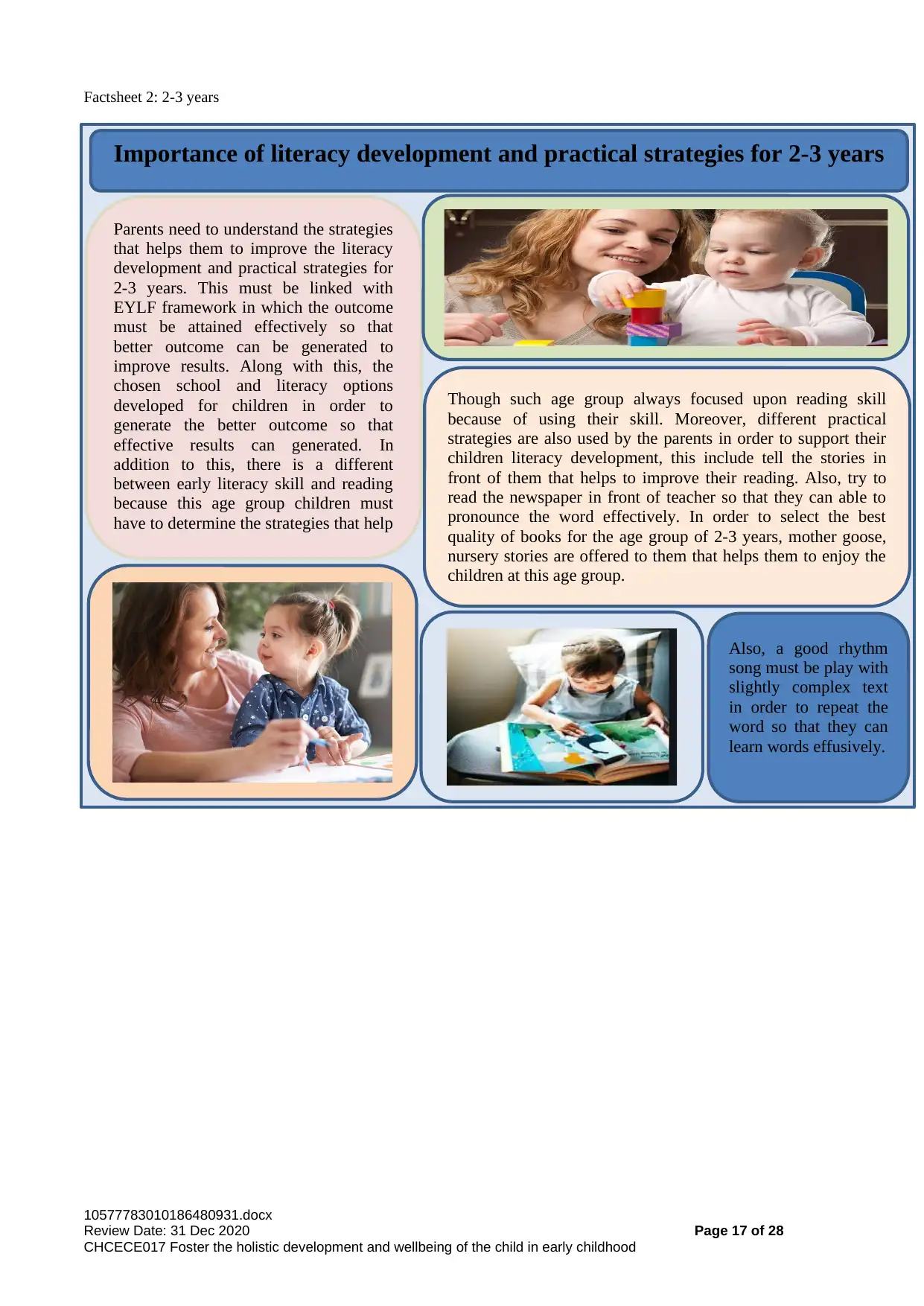
Factsheet 2: 2-3 years
10577783010186480931.docx
Review Date: 31 Dec 2020 Page 17 of 28
CHCECE017 Foster the holistic development and wellbeing of the child in early childhood
Importance of literacy development and practical strategies for 2-3 years
Parents need to understand the strategies
that helps them to improve the literacy
development and practical strategies for
2-3 years. This must be linked with
EYLF framework in which the outcome
must be attained effectively so that
better outcome can be generated to
improve results. Along with this, the
chosen school and literacy options
developed for children in order to
generate the better outcome so that
effective results can generated. In
addition to this, there is a different
between early literacy skill and reading
because this age group children must
have to determine the strategies that help
to create a positive impact.
Though such age group always focused upon reading skill
because of using their skill. Moreover, different practical
strategies are also used by the parents in order to support their
children literacy development, this include tell the stories in
front of them that helps to improve their reading. Also, try to
read the newspaper in front of teacher so that they can able to
pronounce the word effectively. In order to select the best
quality of books for the age group of 2-3 years, mother goose,
nursery stories are offered to them that helps them to enjoy the
children at this age group.
Also, a good rhythm
song must be play with
slightly complex text
in order to repeat the
word so that they can
learn words effusively.
10577783010186480931.docx
Review Date: 31 Dec 2020 Page 17 of 28
CHCECE017 Foster the holistic development and wellbeing of the child in early childhood
Importance of literacy development and practical strategies for 2-3 years
Parents need to understand the strategies
that helps them to improve the literacy
development and practical strategies for
2-3 years. This must be linked with
EYLF framework in which the outcome
must be attained effectively so that
better outcome can be generated to
improve results. Along with this, the
chosen school and literacy options
developed for children in order to
generate the better outcome so that
effective results can generated. In
addition to this, there is a different
between early literacy skill and reading
because this age group children must
have to determine the strategies that help
to create a positive impact.
Though such age group always focused upon reading skill
because of using their skill. Moreover, different practical
strategies are also used by the parents in order to support their
children literacy development, this include tell the stories in
front of them that helps to improve their reading. Also, try to
read the newspaper in front of teacher so that they can able to
pronounce the word effectively. In order to select the best
quality of books for the age group of 2-3 years, mother goose,
nursery stories are offered to them that helps them to enjoy the
children at this age group.
Also, a good rhythm
song must be play with
slightly complex text
in order to repeat the
word so that they can
learn words effusively.
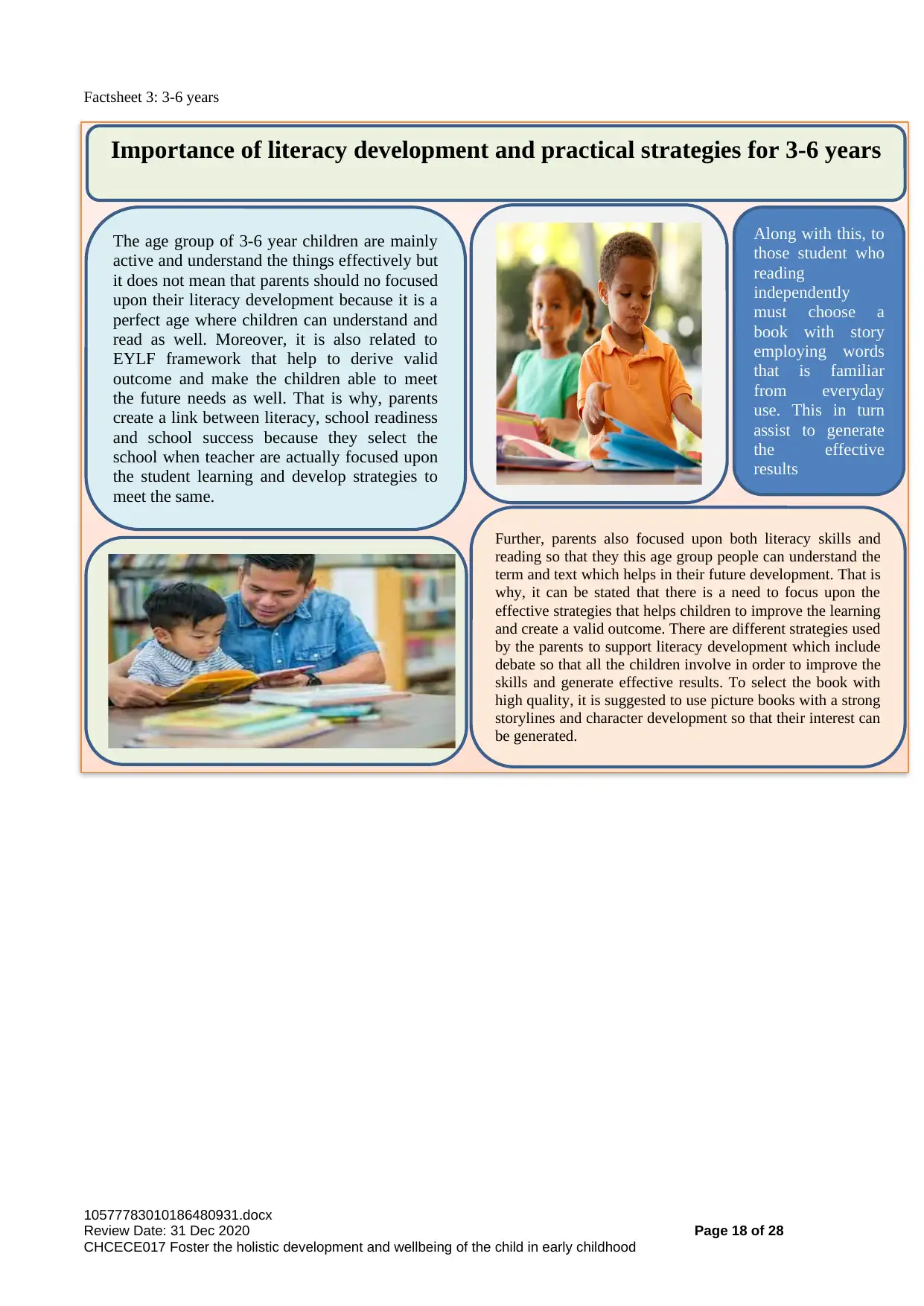
Factsheet 3: 3-6 years
10577783010186480931.docx
Review Date: 31 Dec 2020 Page 18 of 28
CHCECE017 Foster the holistic development and wellbeing of the child in early childhood
Importance of literacy development and practical strategies for 3-6 years
The age group of 3-6 year children are mainly
active and understand the things effectively but
it does not mean that parents should no focused
upon their literacy development because it is a
perfect age where children can understand and
read as well. Moreover, it is also related to
EYLF framework that help to derive valid
outcome and make the children able to meet
the future needs as well. That is why, parents
create a link between literacy, school readiness
and school success because they select the
school when teacher are actually focused upon
the student learning and develop strategies to
meet the same.
Along with this, to
those student who
reading
independently
must choose a
book with story
employing words
that is familiar
from everyday
use. This in turn
assist to generate
the effective
results
Further, parents also focused upon both literacy skills and
reading so that they this age group people can understand the
term and text which helps in their future development. That is
why, it can be stated that there is a need to focus upon the
effective strategies that helps children to improve the learning
and create a valid outcome. There are different strategies used
by the parents to support literacy development which include
debate so that all the children involve in order to improve the
skills and generate effective results. To select the book with
high quality, it is suggested to use picture books with a strong
storylines and character development so that their interest can
be generated.
10577783010186480931.docx
Review Date: 31 Dec 2020 Page 18 of 28
CHCECE017 Foster the holistic development and wellbeing of the child in early childhood
Importance of literacy development and practical strategies for 3-6 years
The age group of 3-6 year children are mainly
active and understand the things effectively but
it does not mean that parents should no focused
upon their literacy development because it is a
perfect age where children can understand and
read as well. Moreover, it is also related to
EYLF framework that help to derive valid
outcome and make the children able to meet
the future needs as well. That is why, parents
create a link between literacy, school readiness
and school success because they select the
school when teacher are actually focused upon
the student learning and develop strategies to
meet the same.
Along with this, to
those student who
reading
independently
must choose a
book with story
employing words
that is familiar
from everyday
use. This in turn
assist to generate
the effective
results
Further, parents also focused upon both literacy skills and
reading so that they this age group people can understand the
term and text which helps in their future development. That is
why, it can be stated that there is a need to focus upon the
effective strategies that helps children to improve the learning
and create a valid outcome. There are different strategies used
by the parents to support literacy development which include
debate so that all the children involve in order to improve the
skills and generate effective results. To select the book with
high quality, it is suggested to use picture books with a strong
storylines and character development so that their interest can
be generated.
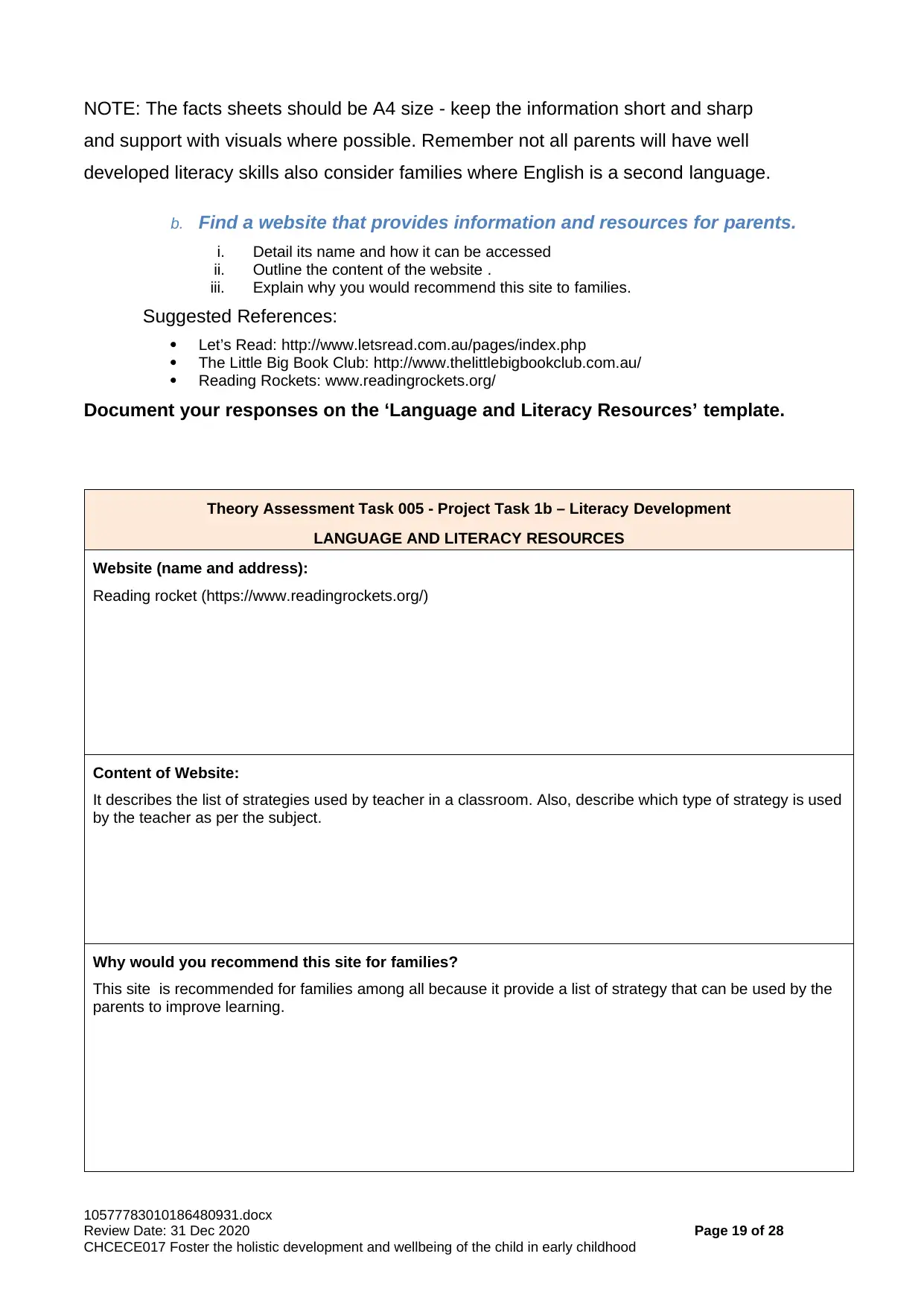
NOTE: The facts sheets should be A4 size - keep the information short and sharp
and support with visuals where possible. Remember not all parents will have well
developed literacy skills also consider families where English is a second language.
b. Find a website that provides information and resources for parents.
i. Detail its name and how it can be accessed
ii. Outline the content of the website .
iii. Explain why you would recommend this site to families.
Suggested References:
Let’s Read: http://www.letsread.com.au/pages/index.php
The Little Big Book Club: http://www.thelittlebigbookclub.com.au/
Reading Rockets: www.readingrockets.org/
Document your responses on the ‘Language and Literacy Resources’ template.
Theory Assessment Task 005 - Project Task 1b – Literacy Development
LANGUAGE AND LITERACY RESOURCES
Website (name and address):
Reading rocket (https://www.readingrockets.org/)
Content of Website:
It describes the list of strategies used by teacher in a classroom. Also, describe which type of strategy is used
by the teacher as per the subject.
Why would you recommend this site for families?
This site is recommended for families among all because it provide a list of strategy that can be used by the
parents to improve learning.
10577783010186480931.docx
Review Date: 31 Dec 2020 Page 19 of 28
CHCECE017 Foster the holistic development and wellbeing of the child in early childhood
and support with visuals where possible. Remember not all parents will have well
developed literacy skills also consider families where English is a second language.
b. Find a website that provides information and resources for parents.
i. Detail its name and how it can be accessed
ii. Outline the content of the website .
iii. Explain why you would recommend this site to families.
Suggested References:
Let’s Read: http://www.letsread.com.au/pages/index.php
The Little Big Book Club: http://www.thelittlebigbookclub.com.au/
Reading Rockets: www.readingrockets.org/
Document your responses on the ‘Language and Literacy Resources’ template.
Theory Assessment Task 005 - Project Task 1b – Literacy Development
LANGUAGE AND LITERACY RESOURCES
Website (name and address):
Reading rocket (https://www.readingrockets.org/)
Content of Website:
It describes the list of strategies used by teacher in a classroom. Also, describe which type of strategy is used
by the teacher as per the subject.
Why would you recommend this site for families?
This site is recommended for families among all because it provide a list of strategy that can be used by the
parents to improve learning.
10577783010186480931.docx
Review Date: 31 Dec 2020 Page 19 of 28
CHCECE017 Foster the holistic development and wellbeing of the child in early childhood
Paraphrase This Document
Need a fresh take? Get an instant paraphrase of this document with our AI Paraphraser
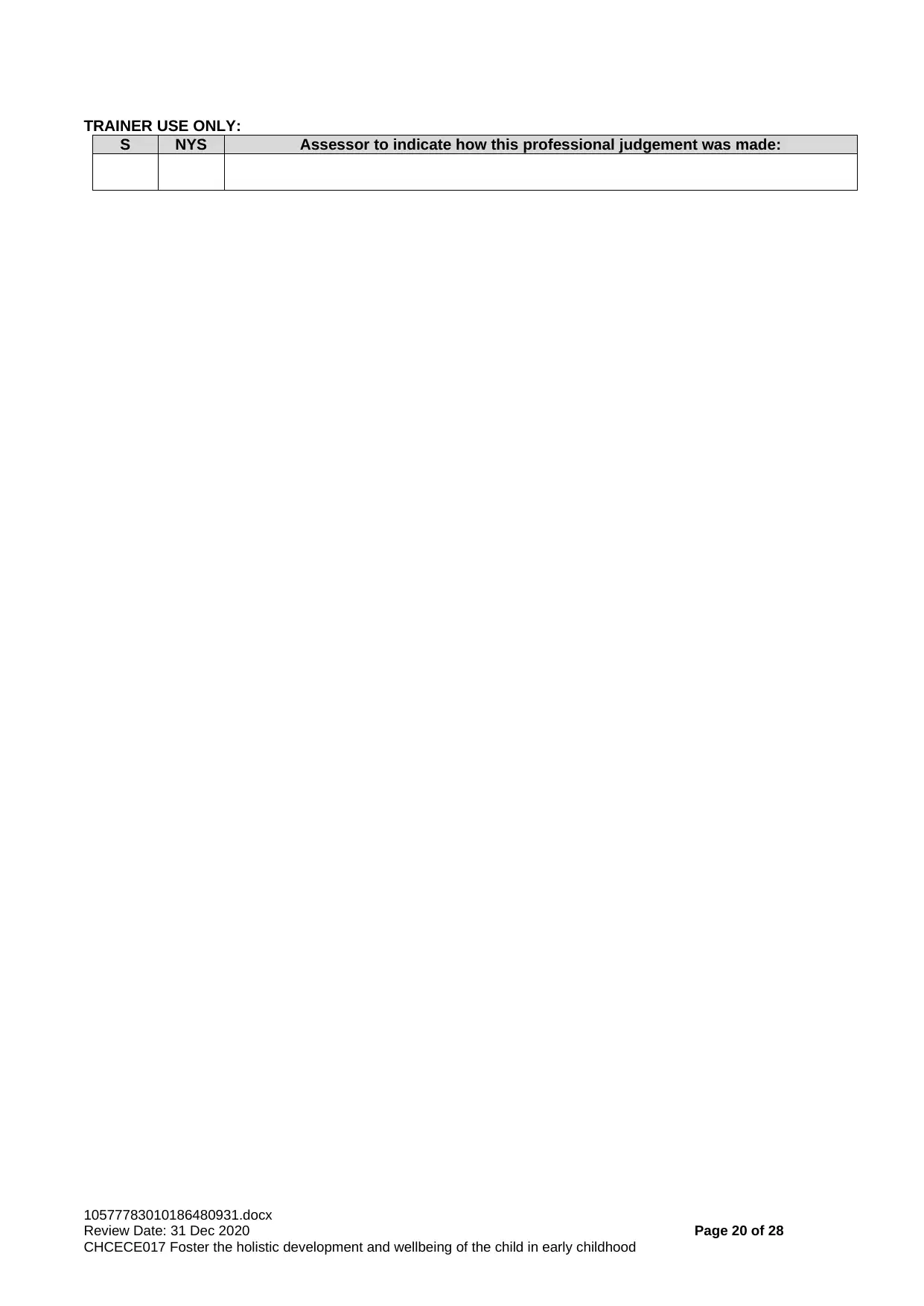
TRAINER USE ONLY:
S NYS Assessor to indicate how this professional judgement was made:
10577783010186480931.docx
Review Date: 31 Dec 2020 Page 20 of 28
CHCECE017 Foster the holistic development and wellbeing of the child in early childhood
S NYS Assessor to indicate how this professional judgement was made:
10577783010186480931.docx
Review Date: 31 Dec 2020 Page 20 of 28
CHCECE017 Foster the holistic development and wellbeing of the child in early childhood
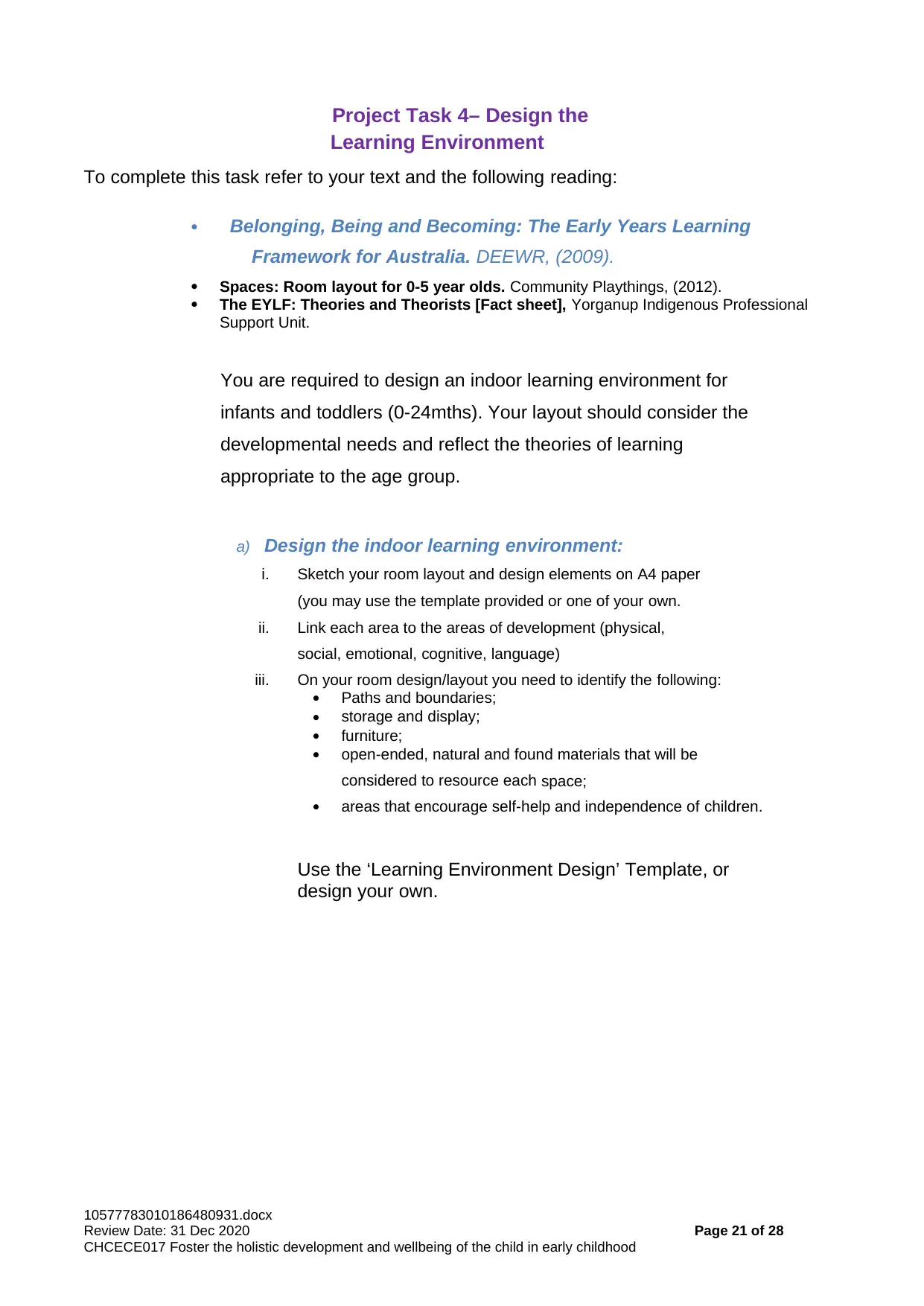
Project Task 4– Design the
Learning Environment
To complete this task refer to your text and the following reading:
Belonging, Being and Becoming: The Early Years Learning
Framework for Australia. DEEWR, (2009).
Spaces: Room layout for 0-5 year olds. Community Playthings, (2012).
The EYLF: Theories and Theorists [Fact sheet], Yorganup Indigenous Professional
Support Unit.
You are required to design an indoor learning environment for
infants and toddlers (0-24mths). Your layout should consider the
developmental needs and reflect the theories of learning
appropriate to the age group.
a) Design the indoor learning environment:
i. Sketch your room layout and design elements on A4 paper
(you may use the template provided or one of your own.
ii. Link each area to the areas of development (physical,
social, emotional, cognitive, language)
iii. On your room design/layout you need to identify the following:
Paths and boundaries;
storage and display;
furniture;
open-ended, natural and found materials that will be
considered to resource each space;
areas that encourage self-help and independence of children.
Use the ‘Learning Environment Design’ Template, or
design your own.
10577783010186480931.docx
Review Date: 31 Dec 2020 Page 21 of 28
CHCECE017 Foster the holistic development and wellbeing of the child in early childhood
Learning Environment
To complete this task refer to your text and the following reading:
Belonging, Being and Becoming: The Early Years Learning
Framework for Australia. DEEWR, (2009).
Spaces: Room layout for 0-5 year olds. Community Playthings, (2012).
The EYLF: Theories and Theorists [Fact sheet], Yorganup Indigenous Professional
Support Unit.
You are required to design an indoor learning environment for
infants and toddlers (0-24mths). Your layout should consider the
developmental needs and reflect the theories of learning
appropriate to the age group.
a) Design the indoor learning environment:
i. Sketch your room layout and design elements on A4 paper
(you may use the template provided or one of your own.
ii. Link each area to the areas of development (physical,
social, emotional, cognitive, language)
iii. On your room design/layout you need to identify the following:
Paths and boundaries;
storage and display;
furniture;
open-ended, natural and found materials that will be
considered to resource each space;
areas that encourage self-help and independence of children.
Use the ‘Learning Environment Design’ Template, or
design your own.
10577783010186480931.docx
Review Date: 31 Dec 2020 Page 21 of 28
CHCECE017 Foster the holistic development and wellbeing of the child in early childhood
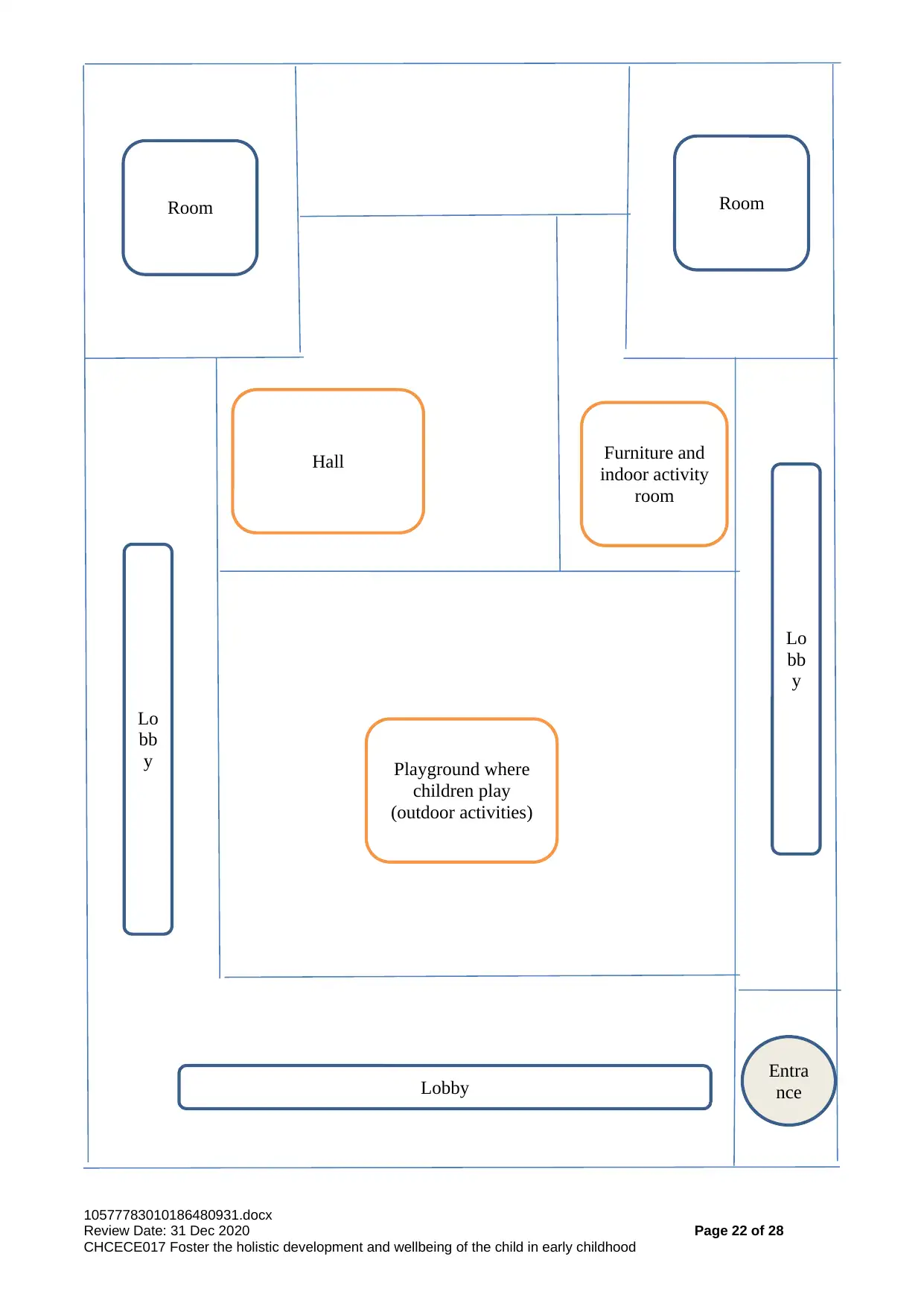
10577783010186480931.docx
Review Date: 31 Dec 2020 Page 22 of 28
CHCECE017 Foster the holistic development and wellbeing of the child in early childhood
Entra
nce
RoomRoom
Lo
bb
y
Lo
bb
y
Hall
Playground where
children play
(outdoor activities)
Furniture and
indoor activity
room
Lobby
Review Date: 31 Dec 2020 Page 22 of 28
CHCECE017 Foster the holistic development and wellbeing of the child in early childhood
Entra
nce
RoomRoom
Lo
bb
y
Lo
bb
y
Hall
Playground where
children play
(outdoor activities)
Furniture and
indoor activity
room
Lobby
Secure Best Marks with AI Grader
Need help grading? Try our AI Grader for instant feedback on your assignments.
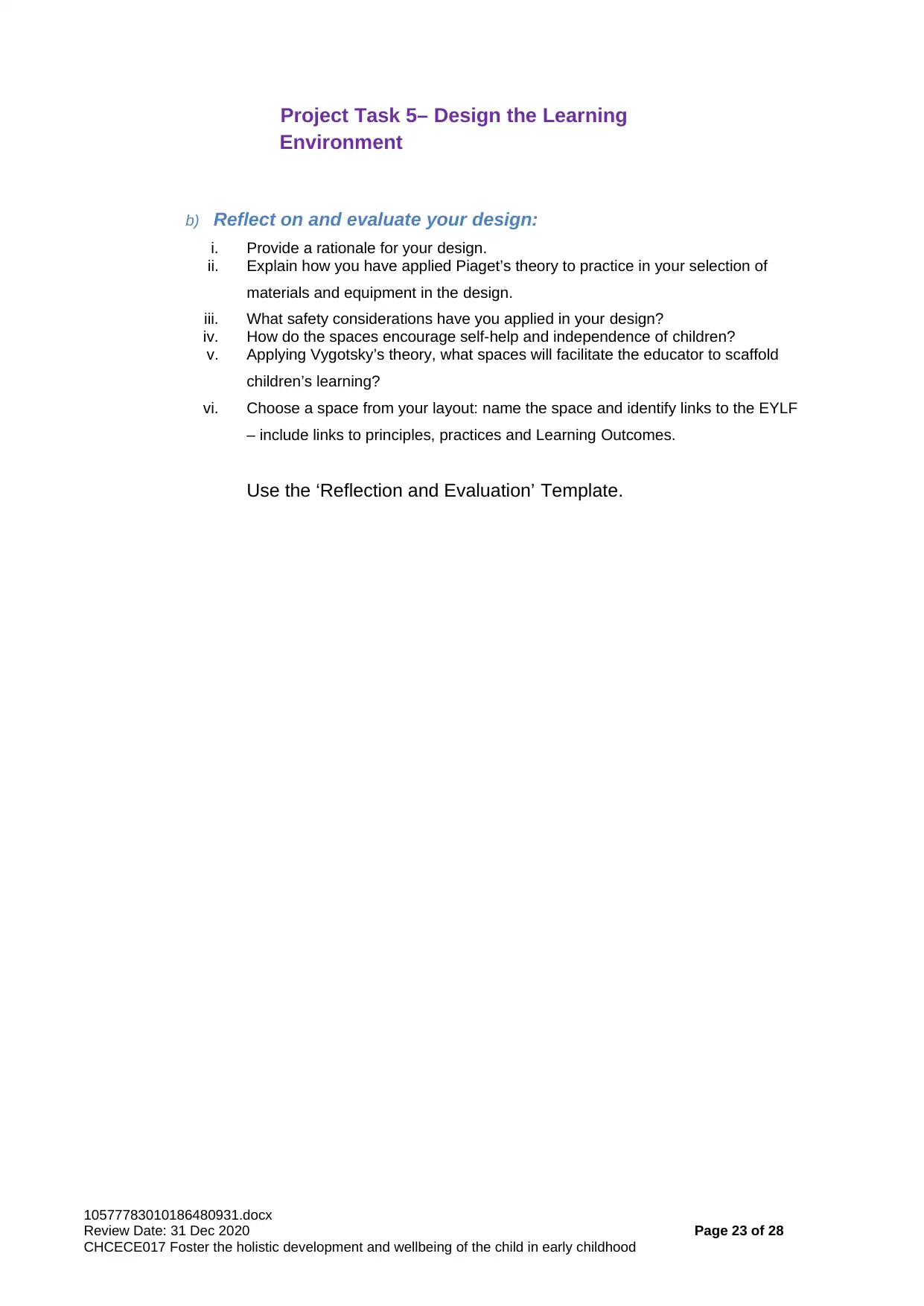
Project Task 5– Design the Learning
Environment
b) Reflect on and evaluate your design:
i. Provide a rationale for your design.
ii. Explain how you have applied Piaget’s theory to practice in your selection of
materials and equipment in the design.
iii. What safety considerations have you applied in your design?
iv. How do the spaces encourage self-help and independence of children?
v. Applying Vygotsky’s theory, what spaces will facilitate the educator to scaffold
children’s learning?
vi. Choose a space from your layout: name the space and identify links to the EYLF
– include links to principles, practices and Learning Outcomes.
Use the ‘Reflection and Evaluation’ Template.
10577783010186480931.docx
Review Date: 31 Dec 2020 Page 23 of 28
CHCECE017 Foster the holistic development and wellbeing of the child in early childhood
Environment
b) Reflect on and evaluate your design:
i. Provide a rationale for your design.
ii. Explain how you have applied Piaget’s theory to practice in your selection of
materials and equipment in the design.
iii. What safety considerations have you applied in your design?
iv. How do the spaces encourage self-help and independence of children?
v. Applying Vygotsky’s theory, what spaces will facilitate the educator to scaffold
children’s learning?
vi. Choose a space from your layout: name the space and identify links to the EYLF
– include links to principles, practices and Learning Outcomes.
Use the ‘Reflection and Evaluation’ Template.
10577783010186480931.docx
Review Date: 31 Dec 2020 Page 23 of 28
CHCECE017 Foster the holistic development and wellbeing of the child in early childhood
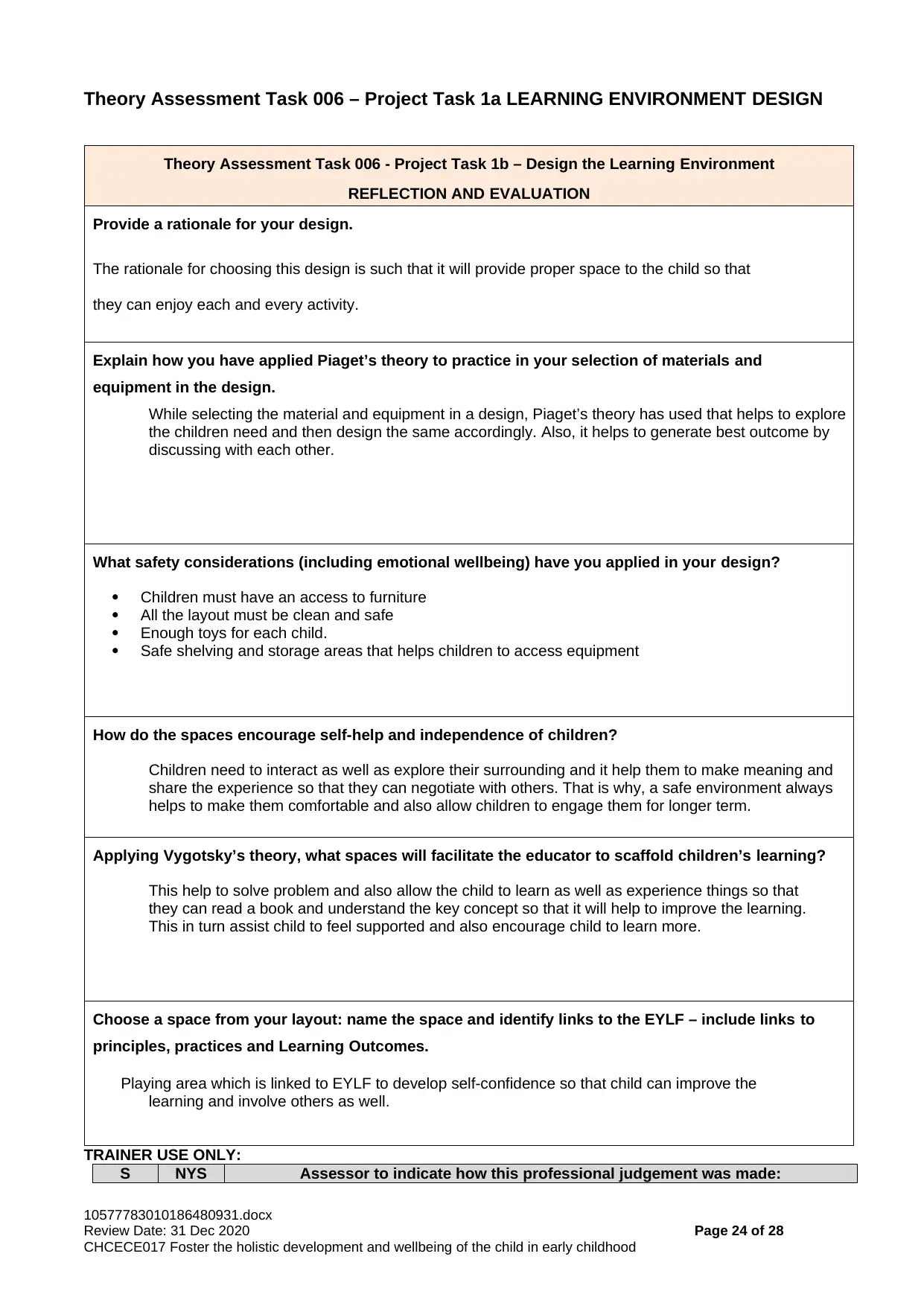
Theory Assessment Task 006 – Project Task 1a LEARNING ENVIRONMENT DESIGN
Theory Assessment Task 006 - Project Task 1b – Design the Learning Environment
REFLECTION AND EVALUATION
Provide a rationale for your design.
The rationale for choosing this design is such that it will provide proper space to the child so that
they can enjoy each and every activity.
Explain how you have applied Piaget’s theory to practice in your selection of materials and
equipment in the design.
While selecting the material and equipment in a design, Piaget’s theory has used that helps to explore
the children need and then design the same accordingly. Also, it helps to generate best outcome by
discussing with each other.
What safety considerations (including emotional wellbeing) have you applied in your design?
Children must have an access to furniture
All the layout must be clean and safe
Enough toys for each child.
Safe shelving and storage areas that helps children to access equipment
How do the spaces encourage self-help and independence of children?
Children need to interact as well as explore their surrounding and it help them to make meaning and
share the experience so that they can negotiate with others. That is why, a safe environment always
helps to make them comfortable and also allow children to engage them for longer term.
Applying Vygotsky’s theory, what spaces will facilitate the educator to scaffold children’s learning?
This help to solve problem and also allow the child to learn as well as experience things so that
they can read a book and understand the key concept so that it will help to improve the learning.
This in turn assist child to feel supported and also encourage child to learn more.
Choose a space from your layout: name the space and identify links to the EYLF – include links to
principles, practices and Learning Outcomes.
Playing area which is linked to EYLF to develop self-confidence so that child can improve the
learning and involve others as well.
TRAINER USE ONLY:
S NYS Assessor to indicate how this professional judgement was made:
10577783010186480931.docx
Review Date: 31 Dec 2020 Page 24 of 28
CHCECE017 Foster the holistic development and wellbeing of the child in early childhood
Theory Assessment Task 006 - Project Task 1b – Design the Learning Environment
REFLECTION AND EVALUATION
Provide a rationale for your design.
The rationale for choosing this design is such that it will provide proper space to the child so that
they can enjoy each and every activity.
Explain how you have applied Piaget’s theory to practice in your selection of materials and
equipment in the design.
While selecting the material and equipment in a design, Piaget’s theory has used that helps to explore
the children need and then design the same accordingly. Also, it helps to generate best outcome by
discussing with each other.
What safety considerations (including emotional wellbeing) have you applied in your design?
Children must have an access to furniture
All the layout must be clean and safe
Enough toys for each child.
Safe shelving and storage areas that helps children to access equipment
How do the spaces encourage self-help and independence of children?
Children need to interact as well as explore their surrounding and it help them to make meaning and
share the experience so that they can negotiate with others. That is why, a safe environment always
helps to make them comfortable and also allow children to engage them for longer term.
Applying Vygotsky’s theory, what spaces will facilitate the educator to scaffold children’s learning?
This help to solve problem and also allow the child to learn as well as experience things so that
they can read a book and understand the key concept so that it will help to improve the learning.
This in turn assist child to feel supported and also encourage child to learn more.
Choose a space from your layout: name the space and identify links to the EYLF – include links to
principles, practices and Learning Outcomes.
Playing area which is linked to EYLF to develop self-confidence so that child can improve the
learning and involve others as well.
TRAINER USE ONLY:
S NYS Assessor to indicate how this professional judgement was made:
10577783010186480931.docx
Review Date: 31 Dec 2020 Page 24 of 28
CHCECE017 Foster the holistic development and wellbeing of the child in early childhood
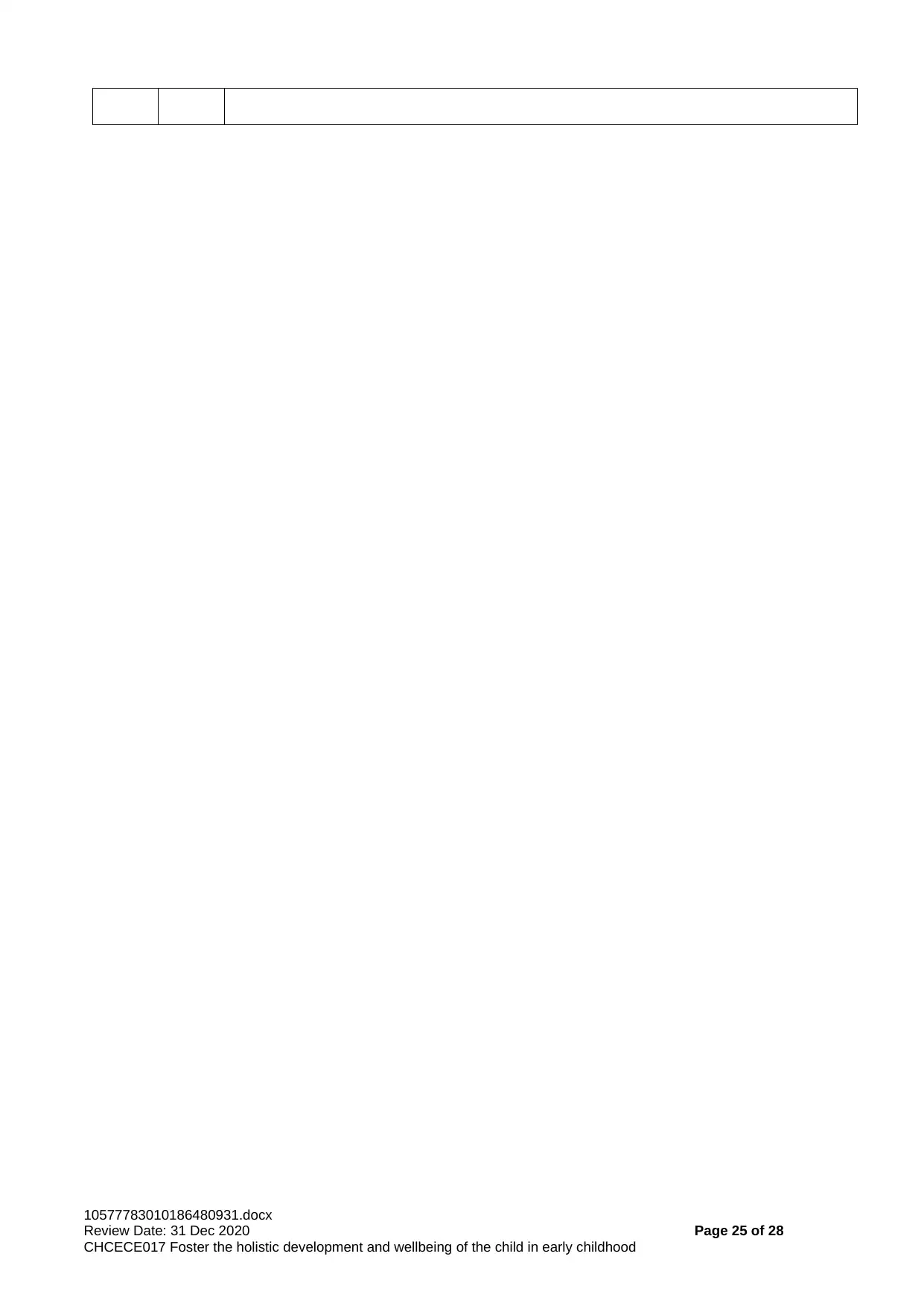
10577783010186480931.docx
Review Date: 31 Dec 2020 Page 25 of 28
CHCECE017 Foster the holistic development and wellbeing of the child in early childhood
Review Date: 31 Dec 2020 Page 25 of 28
CHCECE017 Foster the holistic development and wellbeing of the child in early childhood
Paraphrase This Document
Need a fresh take? Get an instant paraphrase of this document with our AI Paraphraser
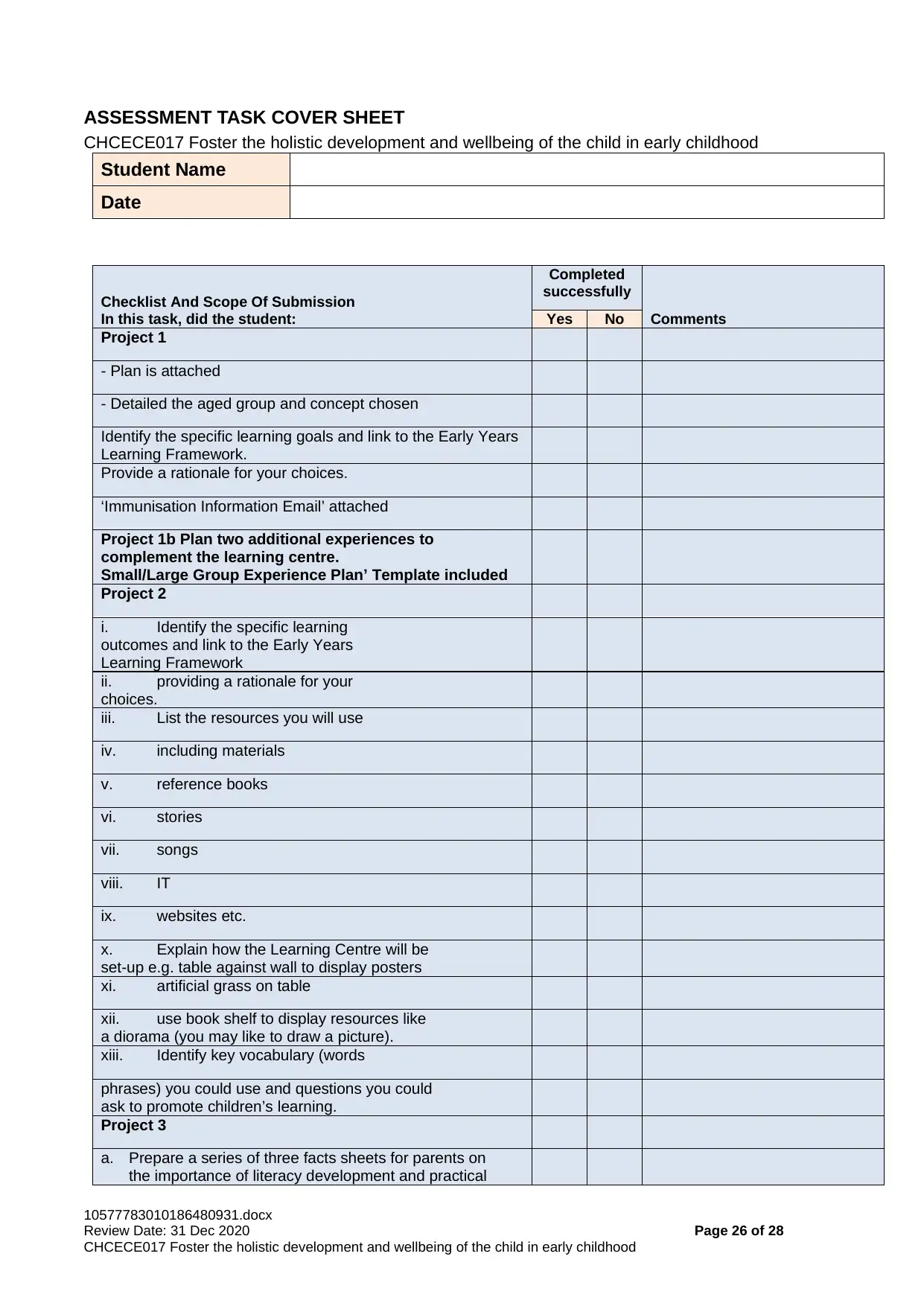
ASSESSMENT TASK COVER SHEET
CHCECE017 Foster the holistic development and wellbeing of the child in early childhood
Student Name
Date
Checklist And Scope Of Submission
In this task, did the student:
Completed
successfully
CommentsYes No
Project 1
- Plan is attached
- Detailed the aged group and concept chosen
Identify the specific learning goals and link to the Early Years
Learning Framework.
Provide a rationale for your choices.
‘Immunisation Information Email’ attached
Project 1b Plan two additional experiences to
complement the learning centre.
Small/Large Group Experience Plan’ Template included
Project 2
i. Identify the specific learning
outcomes and link to the Early Years
Learning Framework
ii. providing a rationale for your
choices.
iii. List the resources you will use
iv. including materials
v. reference books
vi. stories
vii. songs
viii. IT
ix. websites etc.
x. Explain how the Learning Centre will be
set-up e.g. table against wall to display posters
xi. artificial grass on table
xii. use book shelf to display resources like
a diorama (you may like to draw a picture).
xiii. Identify key vocabulary (words
phrases) you could use and questions you could
ask to promote children’s learning.
Project 3
a. Prepare a series of three facts sheets for parents on
the importance of literacy development and practical
10577783010186480931.docx
Review Date: 31 Dec 2020 Page 26 of 28
CHCECE017 Foster the holistic development and wellbeing of the child in early childhood
CHCECE017 Foster the holistic development and wellbeing of the child in early childhood
Student Name
Date
Checklist And Scope Of Submission
In this task, did the student:
Completed
successfully
CommentsYes No
Project 1
- Plan is attached
- Detailed the aged group and concept chosen
Identify the specific learning goals and link to the Early Years
Learning Framework.
Provide a rationale for your choices.
‘Immunisation Information Email’ attached
Project 1b Plan two additional experiences to
complement the learning centre.
Small/Large Group Experience Plan’ Template included
Project 2
i. Identify the specific learning
outcomes and link to the Early Years
Learning Framework
ii. providing a rationale for your
choices.
iii. List the resources you will use
iv. including materials
v. reference books
vi. stories
vii. songs
viii. IT
ix. websites etc.
x. Explain how the Learning Centre will be
set-up e.g. table against wall to display posters
xi. artificial grass on table
xii. use book shelf to display resources like
a diorama (you may like to draw a picture).
xiii. Identify key vocabulary (words
phrases) you could use and questions you could
ask to promote children’s learning.
Project 3
a. Prepare a series of three facts sheets for parents on
the importance of literacy development and practical
10577783010186480931.docx
Review Date: 31 Dec 2020 Page 26 of 28
CHCECE017 Foster the holistic development and wellbeing of the child in early childhood
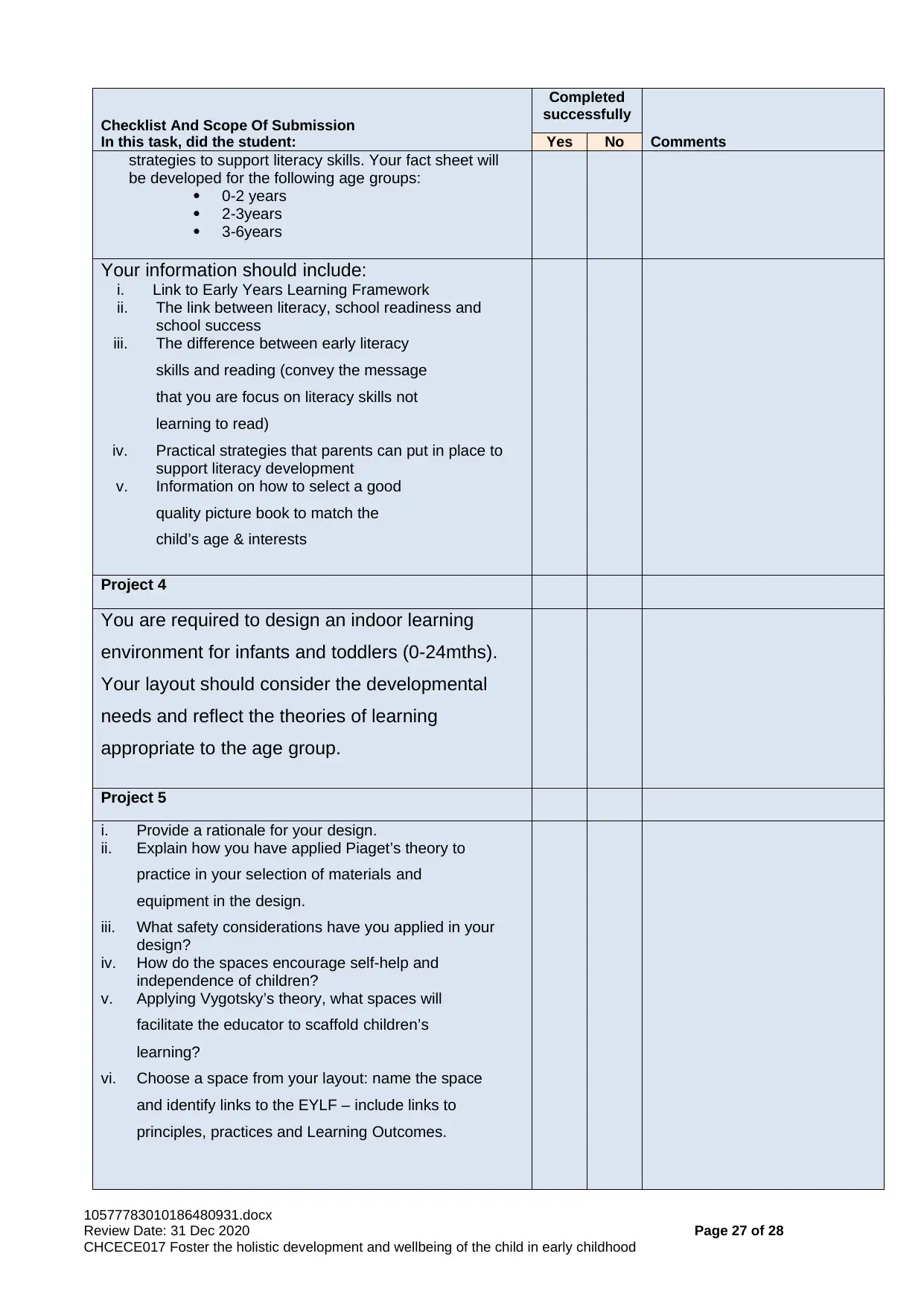
Checklist And Scope Of Submission
In this task, did the student:
Completed
successfully
CommentsYes No
strategies to support literacy skills. Your fact sheet will
be developed for the following age groups:
0-2 years
2-3years
3-6years
Your information should include:
i. Link to Early Years Learning Framework
ii. The link between literacy, school readiness and
school success
iii. The difference between early literacy
skills and reading (convey the message
that you are focus on literacy skills not
learning to read)
iv. Practical strategies that parents can put in place to
support literacy development
v. Information on how to select a good
quality picture book to match the
child’s age & interests
Project 4
You are required to design an indoor learning
environment for infants and toddlers (0-24mths).
Your layout should consider the developmental
needs and reflect the theories of learning
appropriate to the age group.
Project 5
i. Provide a rationale for your design.
ii. Explain how you have applied Piaget’s theory to
practice in your selection of materials and
equipment in the design.
iii. What safety considerations have you applied in your
design?
iv. How do the spaces encourage self-help and
independence of children?
v. Applying Vygotsky’s theory, what spaces will
facilitate the educator to scaffold children’s
learning?
vi. Choose a space from your layout: name the space
and identify links to the EYLF – include links to
principles, practices and Learning Outcomes.
10577783010186480931.docx
Review Date: 31 Dec 2020 Page 27 of 28
CHCECE017 Foster the holistic development and wellbeing of the child in early childhood
In this task, did the student:
Completed
successfully
CommentsYes No
strategies to support literacy skills. Your fact sheet will
be developed for the following age groups:
0-2 years
2-3years
3-6years
Your information should include:
i. Link to Early Years Learning Framework
ii. The link between literacy, school readiness and
school success
iii. The difference between early literacy
skills and reading (convey the message
that you are focus on literacy skills not
learning to read)
iv. Practical strategies that parents can put in place to
support literacy development
v. Information on how to select a good
quality picture book to match the
child’s age & interests
Project 4
You are required to design an indoor learning
environment for infants and toddlers (0-24mths).
Your layout should consider the developmental
needs and reflect the theories of learning
appropriate to the age group.
Project 5
i. Provide a rationale for your design.
ii. Explain how you have applied Piaget’s theory to
practice in your selection of materials and
equipment in the design.
iii. What safety considerations have you applied in your
design?
iv. How do the spaces encourage self-help and
independence of children?
v. Applying Vygotsky’s theory, what spaces will
facilitate the educator to scaffold children’s
learning?
vi. Choose a space from your layout: name the space
and identify links to the EYLF – include links to
principles, practices and Learning Outcomes.
10577783010186480931.docx
Review Date: 31 Dec 2020 Page 27 of 28
CHCECE017 Foster the holistic development and wellbeing of the child in early childhood
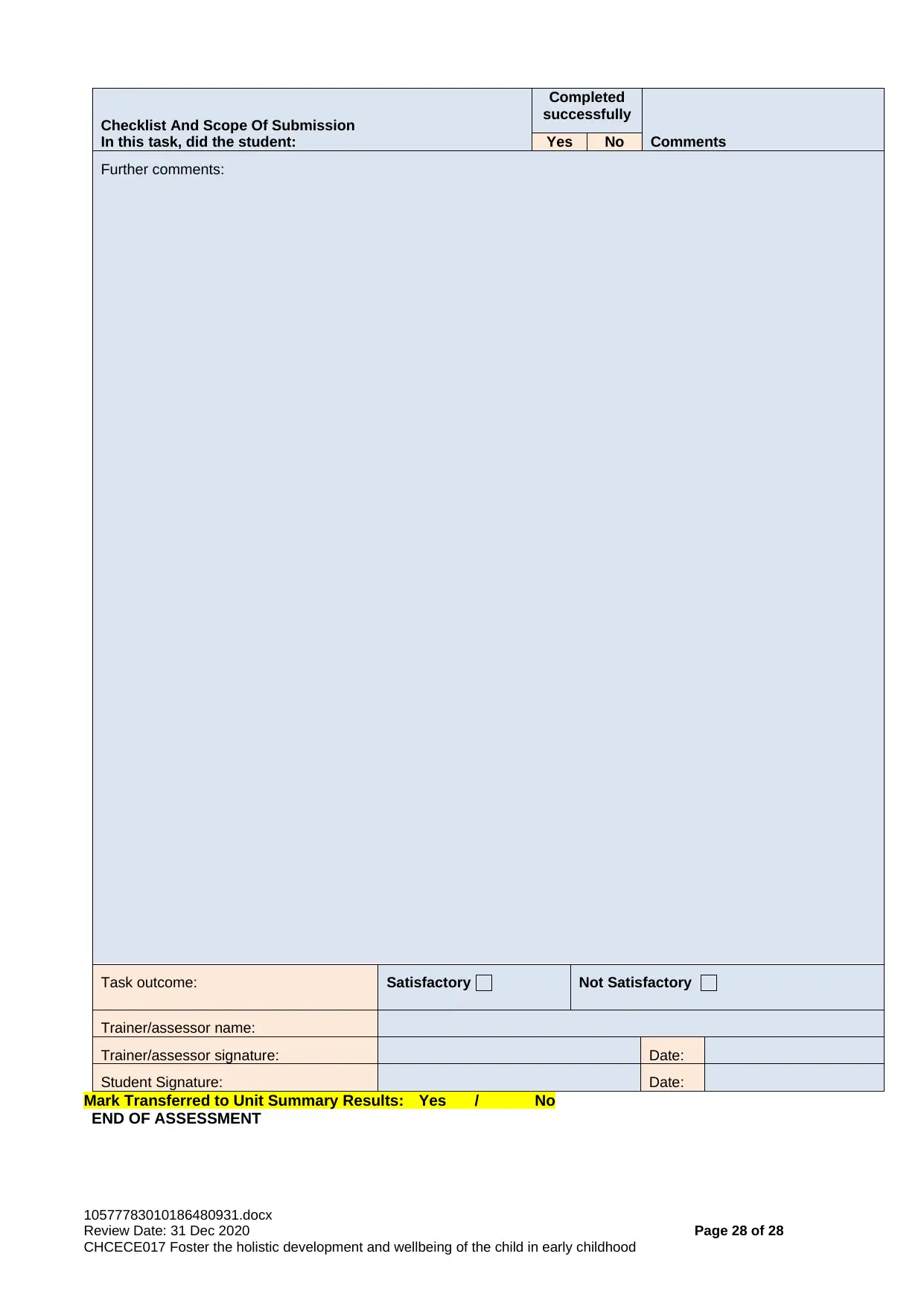
Checklist And Scope Of Submission
In this task, did the student:
Completed
successfully
CommentsYes No
Further comments:
Task outcome: Satisfactory Not Satisfactory
Trainer/assessor name:
Trainer/assessor signature: Date:
Student Signature: Date:
Mark Transferred to Unit Summary Results: Yes / No
END OF ASSESSMENT
10577783010186480931.docx
Review Date: 31 Dec 2020 Page 28 of 28
CHCECE017 Foster the holistic development and wellbeing of the child in early childhood
In this task, did the student:
Completed
successfully
CommentsYes No
Further comments:
Task outcome: Satisfactory Not Satisfactory
Trainer/assessor name:
Trainer/assessor signature: Date:
Student Signature: Date:
Mark Transferred to Unit Summary Results: Yes / No
END OF ASSESSMENT
10577783010186480931.docx
Review Date: 31 Dec 2020 Page 28 of 28
CHCECE017 Foster the holistic development and wellbeing of the child in early childhood
1 out of 28
Related Documents
Your All-in-One AI-Powered Toolkit for Academic Success.
+13062052269
info@desklib.com
Available 24*7 on WhatsApp / Email
![[object Object]](/_next/static/media/star-bottom.7253800d.svg)
Unlock your academic potential
© 2024 | Zucol Services PVT LTD | All rights reserved.




